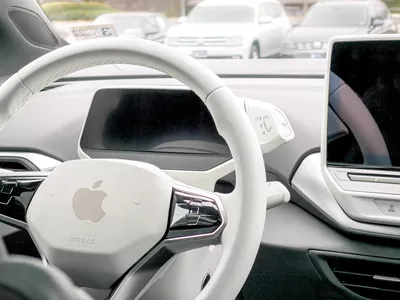
Updated Common Platforms

Common Platforms
Common Platforms for Live Streaming
Maximize your reach with Virbo AI Live Stream on popular live streaming platforms. Uncover the common platforms compatible with our technology!
03 TikTok
04 WeChat Video
05 Kwai
Alibaba International
Operational Steps
- Prepare Equipment, Network, and Browser
- Install Virtual Sound Card
- Due to audio restrictions on Alibaba International, a virtual sound card is required. If your computer’s sound device has a “stereo mix,” it can be used as an alternative. Check the path: My Computer - Properties - Sound - Sound Control Panel - Recording.
- Set Up “Stereo Mix”
- Skip this step if using a virtual sound card.
- Click My Computer - Properties - Sound - Sound Control Panel - Recording, activate stereo sound effects, and set it as default.
- Click Properties - Listen, select your speaker device, and click OK.
- Confirm the settings by playing a video on your computer. If both speakers and the microphone show sound detection, the setup is successful.
- Download and Install OBS
- As Alibaba International has restrictions on webcams, OBS is needed as a virtual camera (future Virbo Live product features will support this).
- After installation, go to Settings - Video and change the resolution to “1080x1920.” Select the “+” sign - Window Capture, and add the window of the Live Explosion (Live Version).
- Crop the URL bar by holding Ctrl + left-click. Click “Start Virtual Camera.”
- Prepare Materials
- Initiate the Live Stream
- Start Live Streaming on Alibaba Seller’s Live Companion
- Log in to Alibaba Seller, open the live stream, and the Alibaba Live Companion window will pop up.
- Choose “Free Mode,” add the camera, select Logitech c930e, and display it to cover the entire screen.
- Set the microphone to stereo mix or virtual sound card, click OK, and confirm the microphone has fluctuations.
- After adding products, click “Start Live” or “Start Reception.”
1688 Live Platform
Operational Steps
- Prepare Equipment, Network, and Browser
- Prepare Materials
- Initiate the Live Stream
- Start Live Streaming on 1688 Live Companion
- Log in to the 1688 Live Companion client, click the material management “+” sign - Window, select the digital person live window, and click OK.
- Zoom in the window to remove the URL bar. Click “Start Streaming,” and the live stream has started.
TikTok
Operational Steps
- Keep your equipment, network, and browser ready
- Please check the Device/Network/Browser Requirements for a detailed guide.
- Initiate the Live Stream
*Download and open the TikTok Live Studio and tap the “add source” icon (+) at the left of the screen.

Login
* Select Virbo LIVE browser (chrome.exe) from the menu. Once you select Virbo LIVE successfully, you’ll be able to see a preview of your video feed.
Adjust source
* In this part, drag and manipulate the controls to adjust the screen, ensuring a perfect showcase.
Adjust screen
- When you’re ready, tap “Go LIVE” to begin streaming.
Note
If your screen shows “ Tiktok Live studio access, it will soon be available.” Stay tuned for updates. This condition means that you still need to meet the requirements for Tiktok Live.
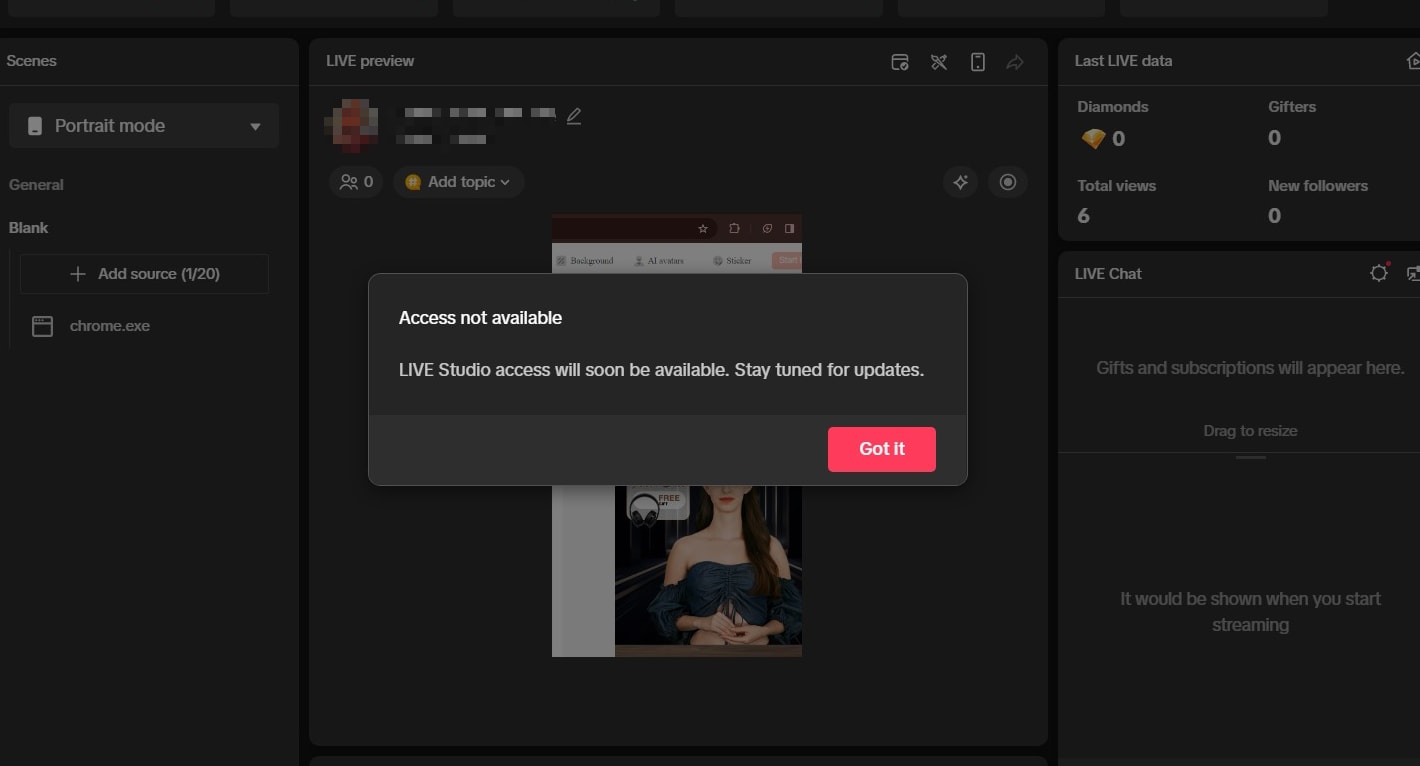
No access
TikTok Live Requirements: 1k followers, 25 min streamed in the last 180 days, and no bans. For details, please click here to get the TikTok Live studio guidelines
WeChat Video
Operational Steps
- Prepare Equipment, Network, and Browser
- Prepare Materials
- Initiate the Live Stream
- Start Live Streaming on WeChat Video Live Companion
- Log in to the WeChat Video Live Companion client, click the material management “+” sign - Window, select the digital person live window, and click OK.
- Alt + mouse or zoom the window to remove the URL bar. Click “Start Live,” and the live stream has started.
Kwai
Operational Steps
- Prepare Equipment, Network, and Browser
- Prepare Materials
- Initiate the Live Stream
- Start Live Streaming on Kuaishou Live Companion
- Log in to the Kuaishou Live Companion client, click the material management “+” sign - Window, select the digital person live window, and click OK.
- Alt + mouse or zoom the window to remove the URL bar. Click “Start Live,” and the live stream has started.
03 TikTok
04 WeChat Video
05 Kwai
Alibaba International
Operational Steps
- Prepare Equipment, Network, and Browser
- Install Virtual Sound Card
- Due to audio restrictions on Alibaba International, a virtual sound card is required. If your computer’s sound device has a “stereo mix,” it can be used as an alternative. Check the path: My Computer - Properties - Sound - Sound Control Panel - Recording.
- Set Up “Stereo Mix”
- Skip this step if using a virtual sound card.
- Click My Computer - Properties - Sound - Sound Control Panel - Recording, activate stereo sound effects, and set it as default.
- Click Properties - Listen, select your speaker device, and click OK.
- Confirm the settings by playing a video on your computer. If both speakers and the microphone show sound detection, the setup is successful.
- Download and Install OBS
- As Alibaba International has restrictions on webcams, OBS is needed as a virtual camera (future Virbo Live product features will support this).
- After installation, go to Settings - Video and change the resolution to “1080x1920.” Select the “+” sign - Window Capture, and add the window of the Live Explosion (Live Version).
- Crop the URL bar by holding Ctrl + left-click. Click “Start Virtual Camera.”
- Prepare Materials
- Initiate the Live Stream
- Start Live Streaming on Alibaba Seller’s Live Companion
- Log in to Alibaba Seller, open the live stream, and the Alibaba Live Companion window will pop up.
- Choose “Free Mode,” add the camera, select Logitech c930e, and display it to cover the entire screen.
- Set the microphone to stereo mix or virtual sound card, click OK, and confirm the microphone has fluctuations.
- After adding products, click “Start Live” or “Start Reception.”
1688 Live Platform
Operational Steps
- Prepare Equipment, Network, and Browser
- Prepare Materials
- Initiate the Live Stream
- Start Live Streaming on 1688 Live Companion
- Log in to the 1688 Live Companion client, click the material management “+” sign - Window, select the digital person live window, and click OK.
- Zoom in the window to remove the URL bar. Click “Start Streaming,” and the live stream has started.
TikTok
Operational Steps
- Keep your equipment, network, and browser ready
- Please check the Device/Network/Browser Requirements for a detailed guide.
- Initiate the Live Stream
*Download and open the TikTok Live Studio and tap the “add source” icon (+) at the left of the screen.

Login
* Select Virbo LIVE browser (chrome.exe) from the menu. Once you select Virbo LIVE successfully, you’ll be able to see a preview of your video feed.
Adjust source
* In this part, drag and manipulate the controls to adjust the screen, ensuring a perfect showcase.
Adjust screen
- When you’re ready, tap “Go LIVE” to begin streaming.
Note
If your screen shows “ Tiktok Live studio access, it will soon be available.” Stay tuned for updates. This condition means that you still need to meet the requirements for Tiktok Live.

No access
TikTok Live Requirements: 1k followers, 25 min streamed in the last 180 days, and no bans. For details, please click here to get the TikTok Live studio guidelines
WeChat Video
Operational Steps
- Prepare Equipment, Network, and Browser
- Prepare Materials
- Initiate the Live Stream
- Start Live Streaming on WeChat Video Live Companion
- Log in to the WeChat Video Live Companion client, click the material management “+” sign - Window, select the digital person live window, and click OK.
- Alt + mouse or zoom the window to remove the URL bar. Click “Start Live,” and the live stream has started.
Kwai
Operational Steps
- Prepare Equipment, Network, and Browser
- Prepare Materials
- Initiate the Live Stream
- Start Live Streaming on Kuaishou Live Companion
- Log in to the Kuaishou Live Companion client, click the material management “+” sign - Window, select the digital person live window, and click OK.
- Alt + mouse or zoom the window to remove the URL bar. Click “Start Live,” and the live stream has started.
Generate Video with Talking Photo Feature
Create a video with Talking Photo
Follow the instructions, and you will learn how to create a video with the talking photo feature on the app.
Note
The talking photo function of the APP allows a single video to be created for up to 30 seconds.
Part 1. Video Tutorial to Create a Talking Photo AI Avatar
Download Virbo App for Free

for iOS

for Android
secure download
Part 2. Step Guidance to Create a Talking Photo AI Avatar
Step 1. Create a new project
Open the Wondershare Virbo app and tap the talking photo function to enter the operation interface.
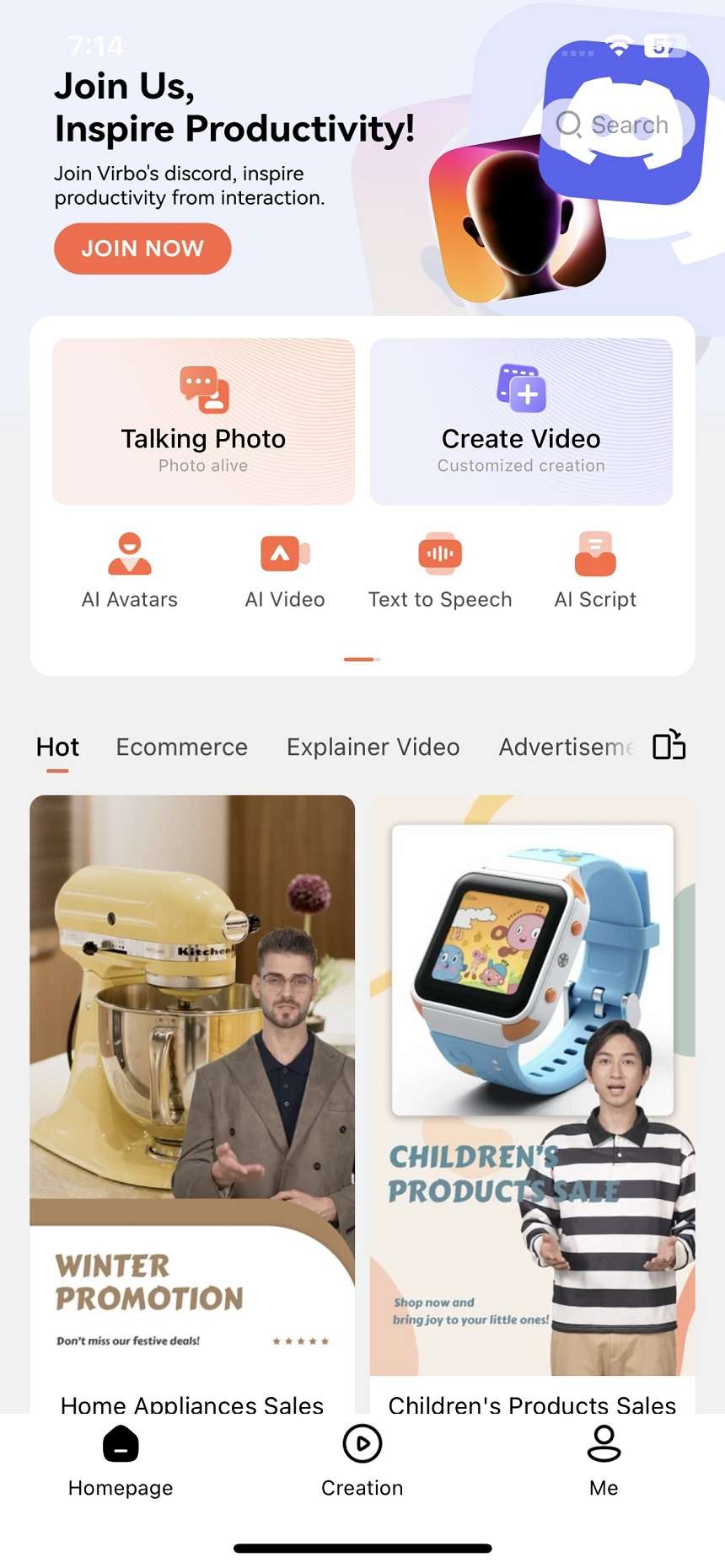
Step 2. Upload a portrait
Tap “try now” and upload a portrait you want to use as your talking avatar by following the instruction.
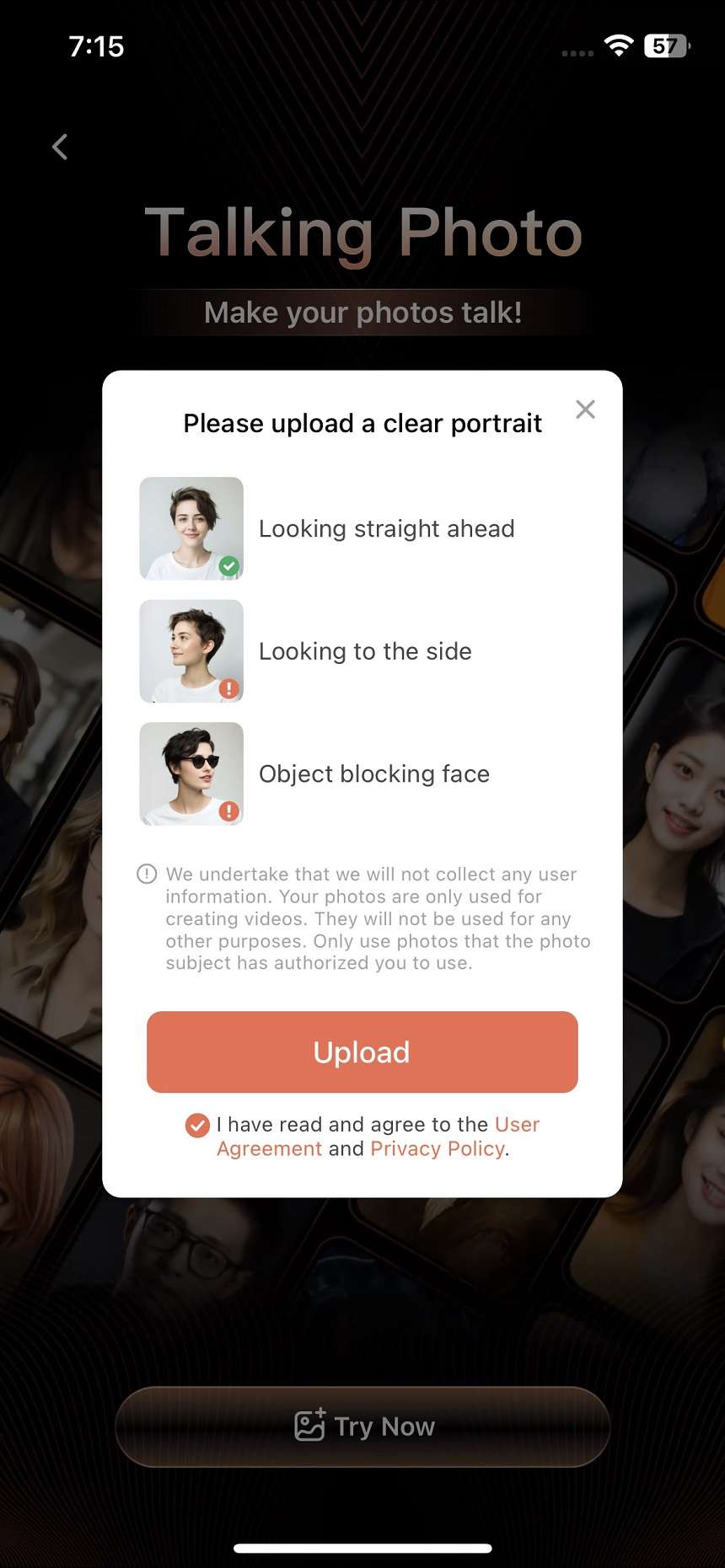
Step 3. Edit and export your video
Enter text and choose a voiceover provided below to generate the voiceover of your video. You can also use your own voice by tapping “record audio”. Once you finished editing the video, tap “Generate Video” to export.
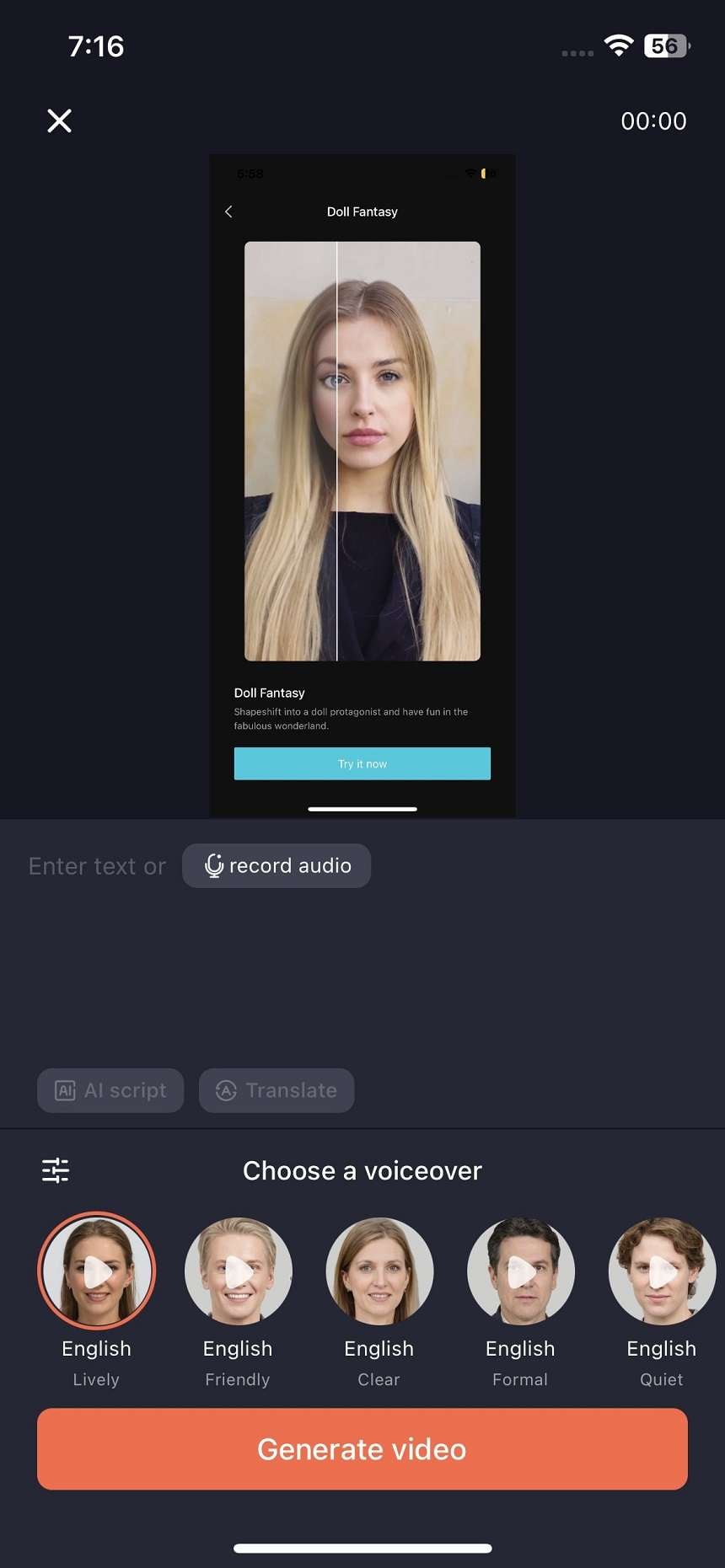
Download Virbo App for Free

for iOS

for Android
secure download
Index
Part 1. Video Tutorial to Create a Talking Photo AI Avatar
Download Virbo App for Free

for iOS

for Android
secure download
Part 2. Step Guidance to Create a Talking Photo AI Avatar
Step 1. Create a new project
Open the Wondershare Virbo app and tap the talking photo function to enter the operation interface.

Step 2. Upload a portrait
Tap “try now” and upload a portrait you want to use as your talking avatar by following the instruction.

Step 3. Edit and export your video
Enter text and choose a voiceover provided below to generate the voiceover of your video. You can also use your own voice by tapping “record audio”. Once you finished editing the video, tap “Generate Video” to export.

Download Virbo App for Free

for iOS

for Android
secure download
Exploring AI Face Generators | Wondershare Virbo Glossary
Part 1. Understanding AI Face Generators
AI face generators are at the forefront of cutting-edge technology, enabling the creation of remarkably authentic and diverse facial images through the ingenious application of deep learning techniques. At the heart of these generators lie concepts like Generative Adversarial Networks (GANs) and Convolutional Neural Networks (CNNs), which synergize to produce digital faces indistinguishable from real individuals’ photographs.
Deep Learning Techniques At the core of AI face generators are GANs, a revolutionary approach to artificial intelligence. GANs consist of two neural networks the generator and the discriminator. The generator crafts synthetic images while the discriminator assesses them for authenticity. Through a cyclic process of creation and evaluation, these networks continuously improve, resulting in ever-more convincing faces.
Data Dynamics A diverse and comprehensive dataset of facial images serves as the training ground for AI face generators. This dataset encompasses faces of different ethnicities, ages, genders, and expressions, allowing the generator to grasp the subtleties contributing to an authentic appearance. Preprocessing techniques, like normalization and augmentation, refine the data, ensuring consistency and enhancing the generator’s ability to create coherent faces.
The Latent Space The concept of a “latent space” is pivotal to the functioning of AI face generators. A latent space represents a multi-dimensional area where vectors carry information that the generator transforms into facial features. By skillfully navigating this space, the generator can produce an array of facial characteristics, ranging from the eyes’ shape to the lips’ curl.
Part 2. Four Key Components of AI Face Generators
AI face generators are complex systems that harness deep learning capabilities to craft lifelike facial images. Understanding their key components is essential to appreciating how these systems create convincing synthetic faces.
1. Generator Network
At the heart of an AI face generator is the generator network. This network learns to transform random noise or latent vectors into detailed and coherent facial images. The generator deciphers patterns in the latent space through layers of neural connections to generate different facial features like eyes, nose, and mouth. As the network refines its understanding through training, it becomes increasingly adept at producing realistic faces.
2. Discriminator Network
The discriminator network acts as the critic in the AI face generator setup. It learns to distinguish between authentic images and those generated by the generator. This adversarial dynamic between the generator and discriminator drives the overall improvement of the generated images. The generator strives to create images that can “fool” the discriminator into classifying them as accurate while the discriminator hones its ability to tell the difference.
3. Latent Space and Noise Vector
The latent space is a multidimensional mathematical space where the generator operates. It’s a representation of all possible facial features that the generator can create. A noise vector, often random values, serves as the starting point in the latent space. As the generator refines these noise vectors through its network layers, they transform into intricate facial characteristics, creating diverse and unique faces.
4. Loss Functions
Loss functions are crucial in training AI face generators, particularly in the context of Generative Adversarial Networks (GANs). The generator’s loss function encourages it to create images convincing to the discriminator. The discriminator’s loss function aims to correctly classify authentic and generated images. The interplay between these loss functions compels both networks to improve iteratively, resulting in increasingly realistic facial photos.
5. Training Data and Preprocessing
The quality of training data significantly impacts the AI face generator’s output. Diverse and representative datasets containing images of various ages, ethnicities, and expressions contribute to more realistic results. Preprocessing techniques like normalization and augmentation ensure consistency and enhance the generator’s capacity to generate coherent faces.
6. Styling and Customization
Advanced AI face generators can incorporate styling and customization options. These allow users to influence specific attributes of the generated faces, such as hairstyle, facial hair, or accessories. This customization capability enhances the generator’s versatility for various applications, from character design in gaming to creating unique avatars.
Understanding these key components provides insight into the inner workings of AI face generators. These systems leverage the interplay of networks, data, and mathematical spaces to achieve their remarkable ability to generate facial images that blur the line between natural and synthetic.
Part 1. Understanding AI Face Generators
AI face generators are at the forefront of cutting-edge technology, enabling the creation of remarkably authentic and diverse facial images through the ingenious application of deep learning techniques. At the heart of these generators lie concepts like Generative Adversarial Networks (GANs) and Convolutional Neural Networks (CNNs), which synergize to produce digital faces indistinguishable from real individuals’ photographs.
Deep Learning Techniques At the core of AI face generators are GANs, a revolutionary approach to artificial intelligence. GANs consist of two neural networks the generator and the discriminator. The generator crafts synthetic images while the discriminator assesses them for authenticity. Through a cyclic process of creation and evaluation, these networks continuously improve, resulting in ever-more convincing faces.
Data Dynamics A diverse and comprehensive dataset of facial images serves as the training ground for AI face generators. This dataset encompasses faces of different ethnicities, ages, genders, and expressions, allowing the generator to grasp the subtleties contributing to an authentic appearance. Preprocessing techniques, like normalization and augmentation, refine the data, ensuring consistency and enhancing the generator’s ability to create coherent faces.
The Latent Space The concept of a “latent space” is pivotal to the functioning of AI face generators. A latent space represents a multi-dimensional area where vectors carry information that the generator transforms into facial features. By skillfully navigating this space, the generator can produce an array of facial characteristics, ranging from the eyes’ shape to the lips’ curl.
Part 2. Four Key Components of AI Face Generators
AI face generators are complex systems that harness deep learning capabilities to craft lifelike facial images. Understanding their key components is essential to appreciating how these systems create convincing synthetic faces.
1. Generator Network
At the heart of an AI face generator is the generator network. This network learns to transform random noise or latent vectors into detailed and coherent facial images. The generator deciphers patterns in the latent space through layers of neural connections to generate different facial features like eyes, nose, and mouth. As the network refines its understanding through training, it becomes increasingly adept at producing realistic faces.
2. Discriminator Network
The discriminator network acts as the critic in the AI face generator setup. It learns to distinguish between authentic images and those generated by the generator. This adversarial dynamic between the generator and discriminator drives the overall improvement of the generated images. The generator strives to create images that can “fool” the discriminator into classifying them as accurate while the discriminator hones its ability to tell the difference.
3. Latent Space and Noise Vector
The latent space is a multidimensional mathematical space where the generator operates. It’s a representation of all possible facial features that the generator can create. A noise vector, often random values, serves as the starting point in the latent space. As the generator refines these noise vectors through its network layers, they transform into intricate facial characteristics, creating diverse and unique faces.
4. Loss Functions
Loss functions are crucial in training AI face generators, particularly in the context of Generative Adversarial Networks (GANs). The generator’s loss function encourages it to create images convincing to the discriminator. The discriminator’s loss function aims to correctly classify authentic and generated images. The interplay between these loss functions compels both networks to improve iteratively, resulting in increasingly realistic facial photos.
5. Training Data and Preprocessing
The quality of training data significantly impacts the AI face generator’s output. Diverse and representative datasets containing images of various ages, ethnicities, and expressions contribute to more realistic results. Preprocessing techniques like normalization and augmentation ensure consistency and enhance the generator’s capacity to generate coherent faces.
6. Styling and Customization
Advanced AI face generators can incorporate styling and customization options. These allow users to influence specific attributes of the generated faces, such as hairstyle, facial hair, or accessories. This customization capability enhances the generator’s versatility for various applications, from character design in gaming to creating unique avatars.
Understanding these key components provides insight into the inner workings of AI face generators. These systems leverage the interplay of networks, data, and mathematical spaces to achieve their remarkable ability to generate facial images that blur the line between natural and synthetic.
Top 6 Mickey Mouse Voice Generators
One of the most beloved and hyped animated characters of Disney with tons of fans is Mickey Mouse. From adults to children, people love to walk and talk like Mickey Mouse. In today’s world, you can express your love for your favorite character in several ways. One of them is to change your voice with them.
You must be thinking that is it even possible? The answer is Yes, but you have to be careful while selecting the Micky voice generator tool. No need to fret because by the end of this article, you will know the reliable tools to turn your voice into Mickey Mouse.
Part 1: What Are The Uses Of Mickey Mouse Voice Generator
Mickey Mouse is an anthropomorphic character that has billions of fans all around the globe. Other than this, people appreciate Mickey for its character, plot, and theme. If you are new to voice generators, you must be wondering why you should use the Mickey Mouse voice generator. What effective things it can bring for you. The understated points will help you to understand the uses of Mickey Mouse voices:
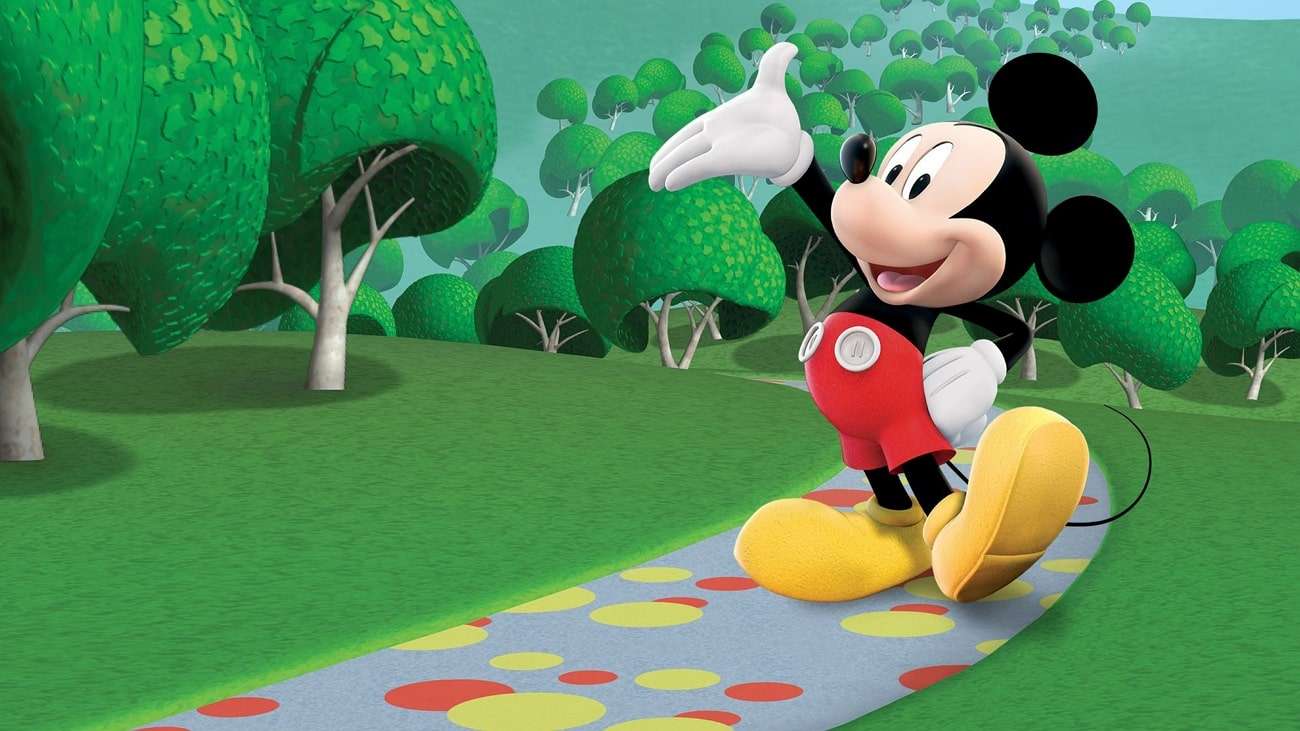
- Entertainment Content: With the help of a reliable Mickey voice generator, you can create entertainment content for the audience. It also assists you in pranking people and presenting yourself as a comedic person.
- Production and Services: These voice generators can also help you with dubbing and parody. You can also create commercials and videos themed on Mickey Mouse. Moreover, you can also give birthday party services while sounding like Mickey Mouse.
- Virtual Reality Projects: You can enhance the overall experience of the users with Mickey Mouse voices. It can also help you interact with audiences to get better engagement in virtual reality projects.
- Children’s App and Games: You can also make children happy by sounding like Mickey Mouse. Not only in real life, but you can also change your voice to Mickey Mouse on apps and games.
Part 2: The Best Online Mickey Mouse Voice Generators to Use on All Browsers
A wide array of online Mickey Mouse voice generators can help you create beneficial content. To learn the reliable tools to sound like Mickey Mouse, jump below:
1. Uberduck
Using this extraordinary tool, you can create videos based on Mickey Mouse’s voices. As it can create realistic quality videos, people will not know that you are using a Mickey voice generator for this purpose. Other than Mickey Mouse, it also has 5000+ expressive voices.
There are specialized APIs through which you can create premium-quality audio apps quickly. You need to select the voice category, select voice, and upload or record your audio. After that, Uberduck will handle the rest for you.
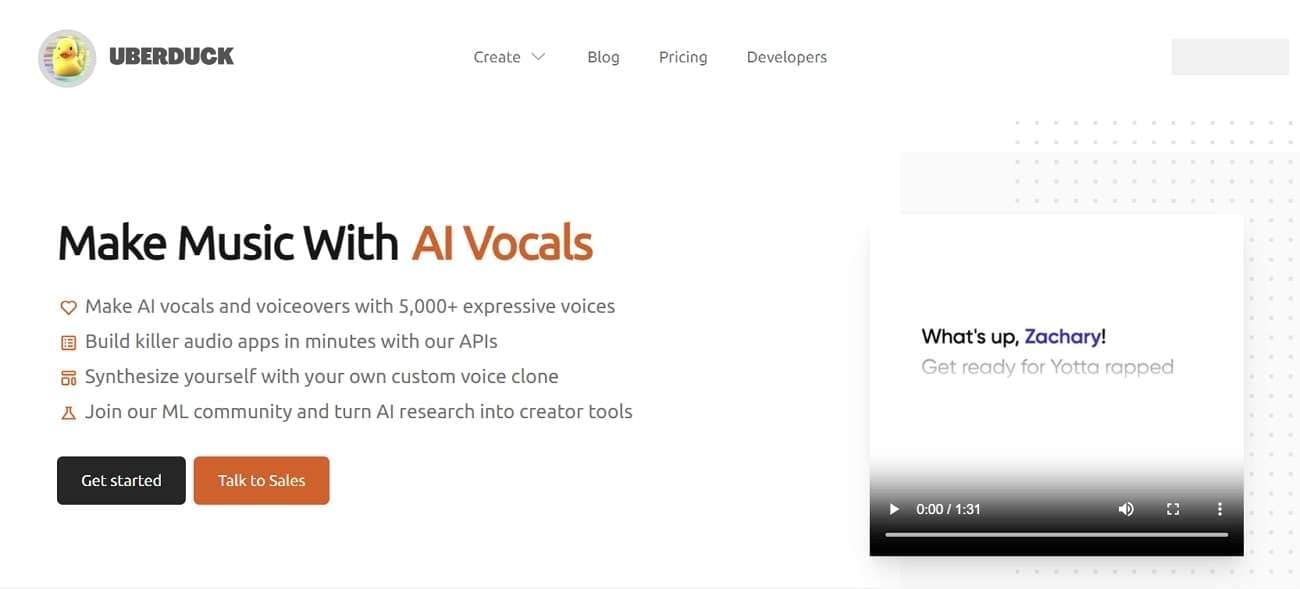
Key Features
- With this reliable tool, you can even convert written text into listenable speeches without leaving anything behind.
- It also integrates the features of AI-Generated raps. Through this, you can create raps on customized beats and verses.
- Using its Custom Voice Clones, you can create clones of anyone’s voice without issue. You can also add reference audio to get the best results.
2. FakeYou
As the name indicates, you can fake your voice with any character or person in lossless quality. This exceptional voice generator allows you to create up to 2 and 5 minutes of fake-voiced videos and audio. It has more than 3000 voices, so you will not face any restrictions in this part. Above all, it also lets you select and control the pitch of the audio.
You can even use this tool to convert one audio into another format so you can share it without any restrictions. Furthermore, you can either use a microphone to record audio or upload the audio of your own choice.
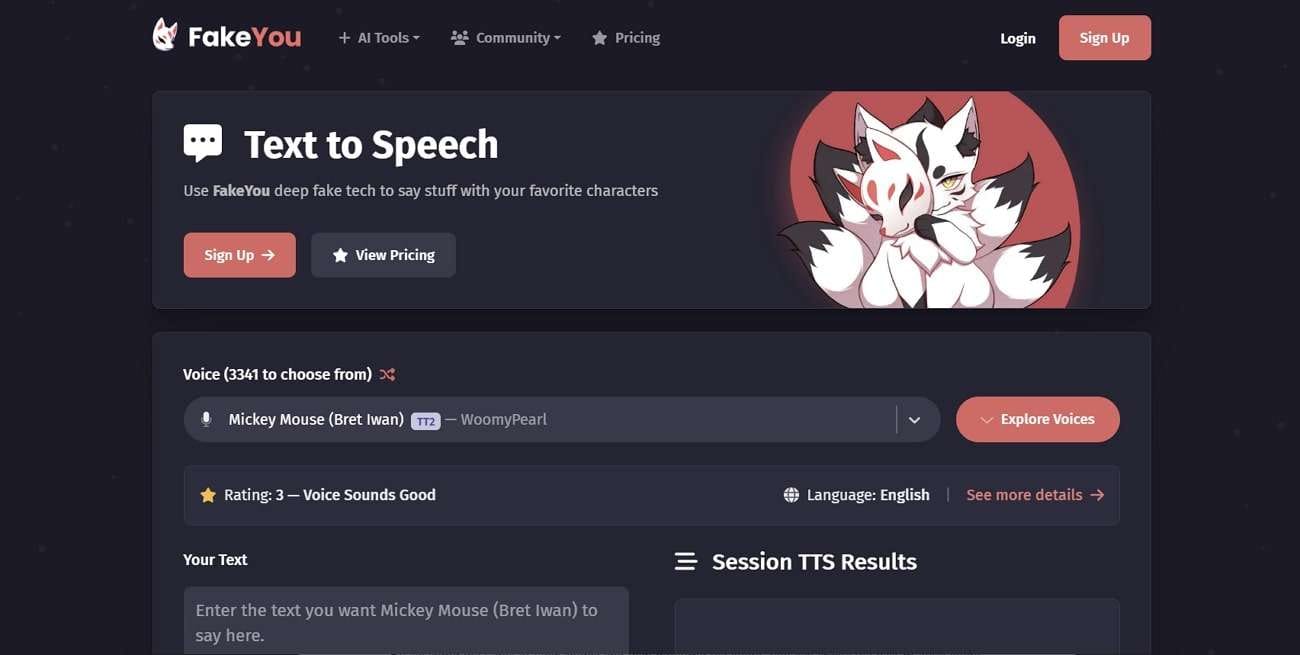
Key Features
- You can turn the written text into reliable speech in the voice of your favorite character.
- There are endless templates in it that can help you complete your projects in a limited time.
- This tool also has the potential to create lip-synchronized videos, which add a more realistic touch to the videos.
3. Voicechanger.io
This amazing Micky voice generator gives you diversified options for adding audio. This may include video upload, microphone recording, or getting a speech from written text. The interface of this tool is basic, so you will be fine with this. Moreover, you can also get the audio in the voice of your choice.
By selecting the voice of your choice and then inputting the audio, you can create the best-in-class audio. You also have a chance to select the voice style from the male and female options. This tool doesn’t include the Mickey Mouse voice present, but you can create one with it.
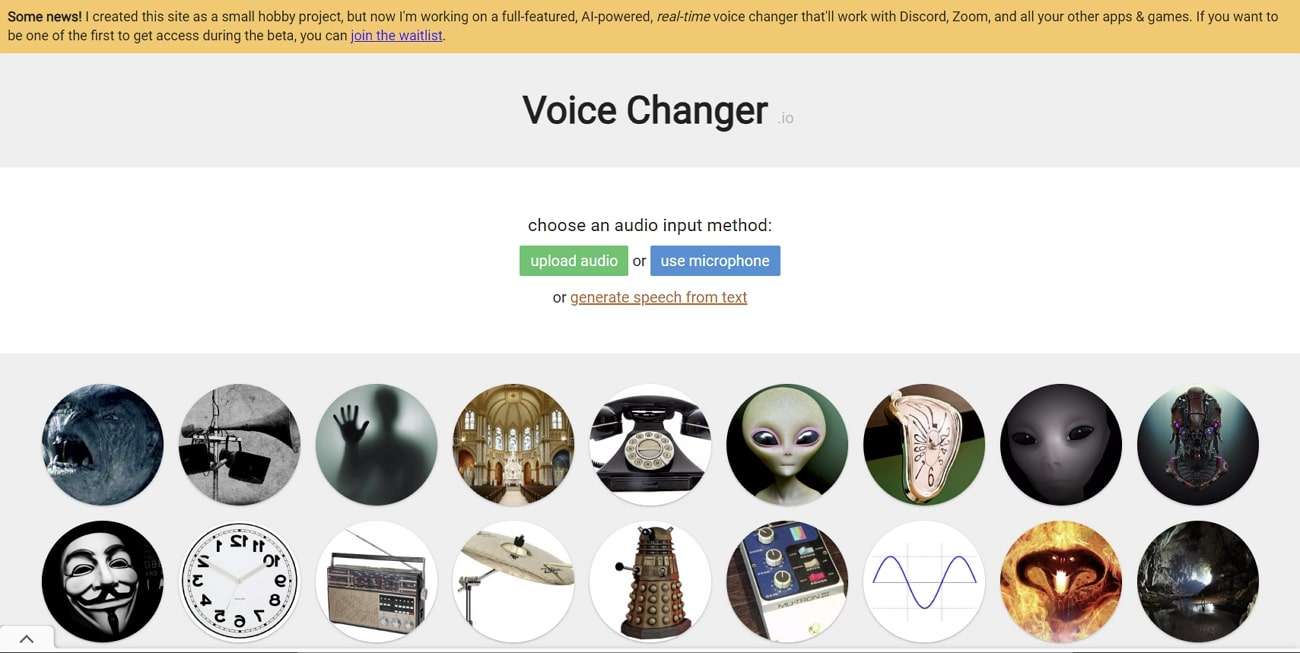
Key Features
- It has a specialized Pitch Shift through which you can give more personalized output to the generated voice.
- You can also share the link of the generated voice to several social media platforms to attract a substantial number of users.
- If you do not like the generated audio, click the Regenerate button to make it again. It also lets you download the audio to the device.
Part 3: 3 Recommended Offline Micky Voice Generator Tools for High Quality
Sometimes, the users need to use a tool for a longer period. If you also think you will need Mickey voice generators for longer, consider using offline tools. The reliable offline tools to generate the Mickey Mouse voice-integrated audios are discussed here:
1. Voicemod
It is a real-time voice changer that you can access to work offline. It helps you make your identity on major platforms such as Roblox, VRChat, and more. You can also add custom voice effects with this premium-grade tool.
Moreover, you can also work on previously made WAV or MP3 files without complication. It has a dependable library having voice effects on numerous occasions such as Halloween or April Fool.
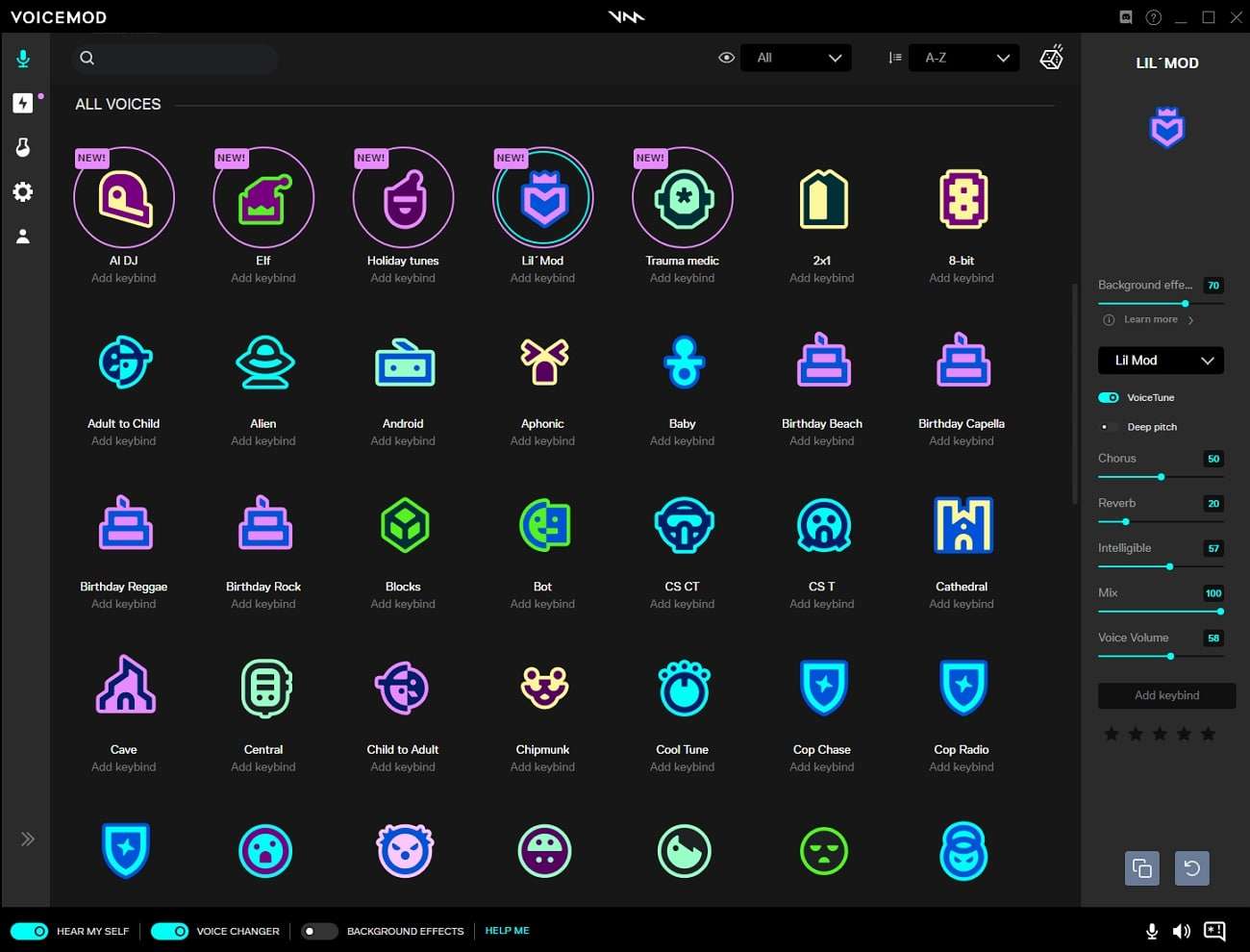
Key Features
- You can enable the Resonator option anytime to ensure more realistic voices in your audio.
- It also lets you mix the audio and equalize the volume for every audio individually.
- This tool can add multiple effects together in the audio and customize its metrics.
2. UnicTool MagicVox
There are almost 400 voice effects in it which can maximize the productivity of your audio without any issues. No matter if you want to sound like the anime girl or Darth Vader, this amazing Mickey Mouse voice generator can help you.
Moreover, its voice cloning technology can even replicate the voices for creating professional soundboards. You can also change your voice on major platforms like Zoom and Google Meet in real time.
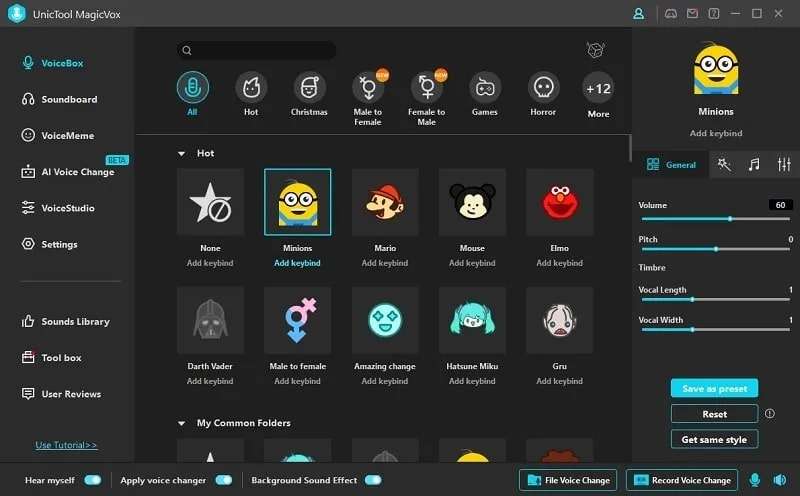
Key Features
- It encompasses soundboards through which you can create customized effects and share them with the world.
- You can create custom voices by using the Voice Studio of UnicTool MagicVox. It also lets you perfect your identity.
- UnicTool MagicVox allows you to record the audio and download them in MP3 or MAV format.
3. iMyFone VoxBox
Using this extraordinary Mickey voice generator, you can dub the voices in more than 46 languages. It also integrates 3200 voices that never fail to amaze the realistic voice clones. This tool can also handle the TTS, SSL, conversion, and other audio parameters.
As it supports multiple formats for both input and output audio formats, you will be fine with this. You can also add well-synced voiceovers in the videos with this.
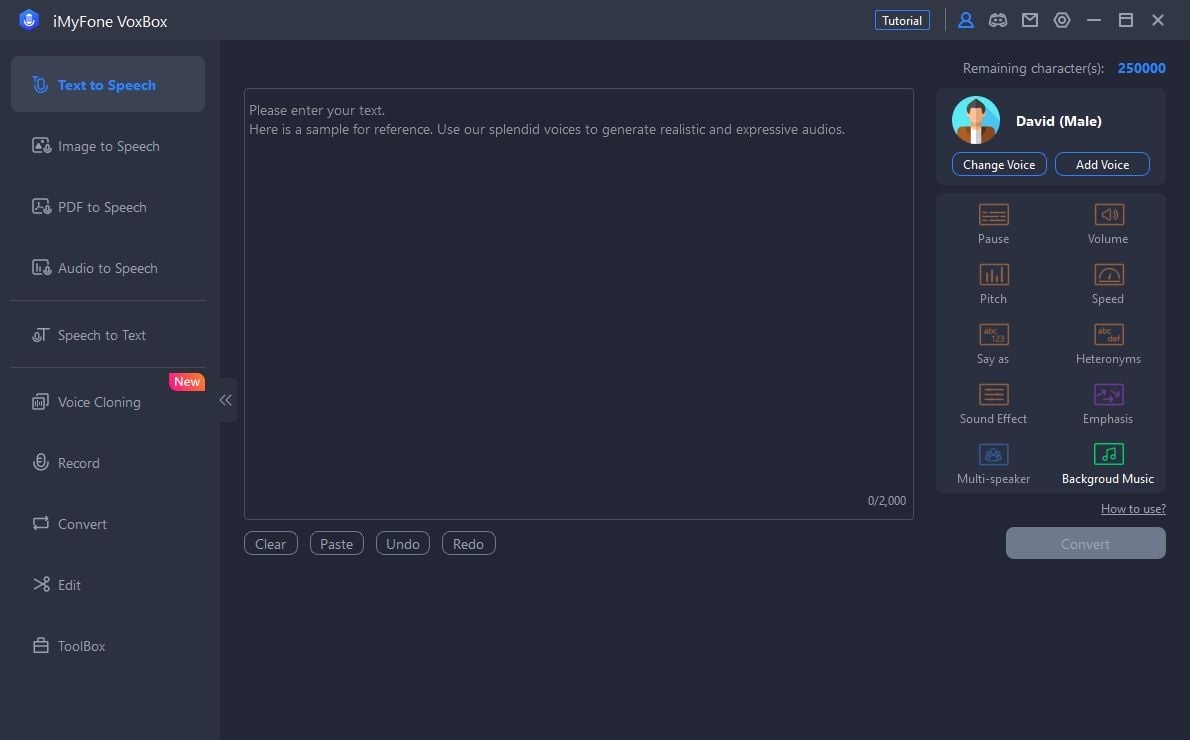
Key Features
- It lets you select the volume, emphasis, and pitch of the audio in a customized manner.
- You can also turn PDF, image, and simple text into speech and add customized intervals.
- This tool can also handle audio editing, audio plus video conversion, text extraction, and transliteration for you.
Bonus Tip: Efficient and AI-Powered AI Voice Generator For Creating Business Videos
Generate Engaging
AI Video in Minutes!
Easily convert text into professional spokesperson videos in over 120+ voices & languages in minutes.
Generate AI Video Free Generate AI Video Now
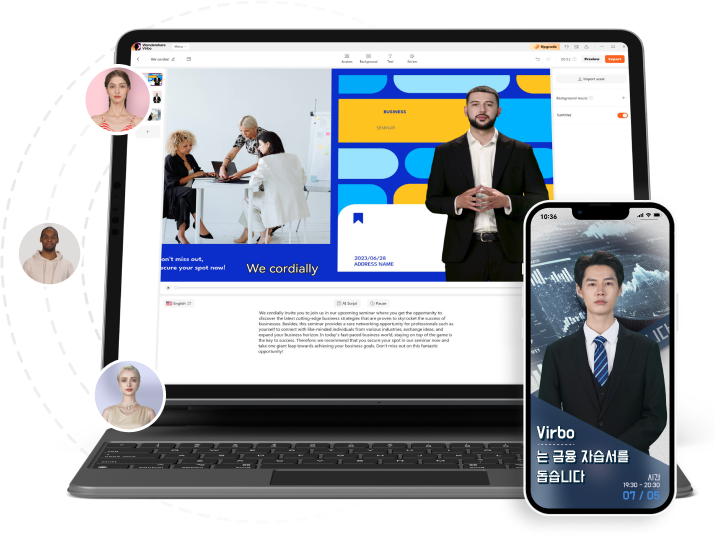
Do you wish to create expressive text for speech videos? No need to worry because Virbo can help you with this. You can use Virbo to create best-in-class AI videos that can engage many users. Adding text and customizing the voice style allows you to get text-to-speech content in a limited time.
Virbo also has endless templates and royalty-free music. You can also use its AI Script feature to generate scripts for social media. It comprehends a huge array of AI Avatars that can upgrade your performance in a limited time. Moreover, you can use Virbo on several platforms with data synchronization.
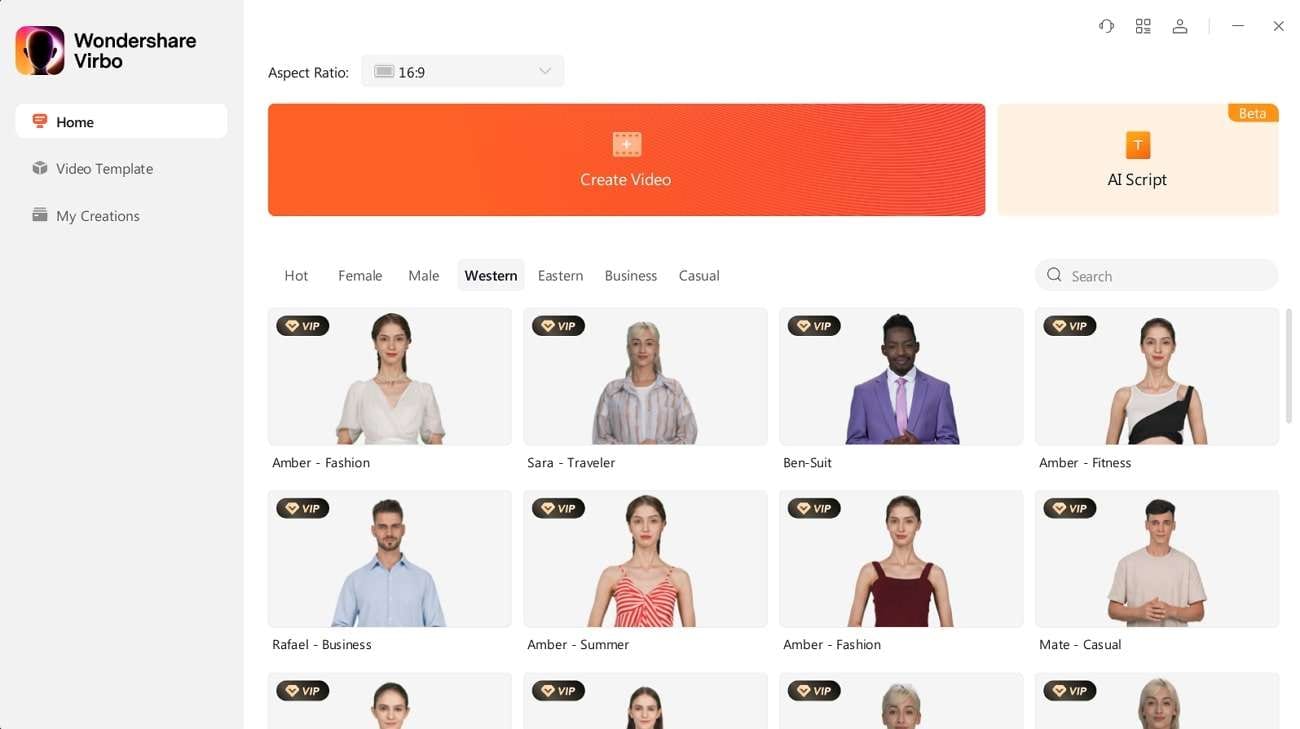
Conclusion
In the following article, you have discovered the information about Mickey Mouse’s voice generator. There are diversified points that ensure the usability of Mickey Mouse’s voice. A few of them are discussed above for you. In addition to this, you can use both online and offline software to accomplish this task.
The best online Mickey voice generators are Uberduck, FakeYou, and voicechanger.ai. Voicemod, UnicTool, and iMyFone can assist you as offline tools. You can also use Virbo to generate highly engaging text-to-speech videos.
Material Preparation | Virbo AI Live Stream
Material Preparation for Live Streaming
Elevate your content and captivate your audience effortlessly with our comprehensive insights. Dive into the details for a seamless and professional live-streaming experience.
By meticulously preparing these materials, you are setting the stage for a captivating and interactive digital live-streaming experience. Get started now!
05 Live Stream Room Background
Live Streaming Script
1 Word Count: Suggested minimum of 5,000 words, with a maximum limit of 50,000 words.
2 Live Script Framework Reference: Structure each round with “Interactive Dialogue + Company Introduction + Product Introduction + Promotion Dialogue + Closing Dialogue” and script multiple rounds.
Greeting Dialogues
1 Craft authentic greeting dialogues to establish a more genuine live-streaming atmosphere and enhance interactive engagement.
Q&A Dialogues
1 Prepared Q&A dialogues ensure timely interaction with users when questions arise during the live stream, enhancing retention and conversion in the live stream room.
Product Images or Videos
1 To provide audiences with a better understanding of the products, it is advised to prepare clear product usage videos or images to create an immersive experience.
Live Stream Room Background
1 Please upload images or videos in a 9:16 ratio.
2 Image formats supported include JPG/JPEG/PNG, and video formats supported include MP4/MOV.
3 The maximum duration for video backgrounds is 30 minutes, with a file size limit of 1GB.
05 Live Stream Room Background
Live Streaming Script
1 Word Count: Suggested minimum of 5,000 words, with a maximum limit of 50,000 words.
2 Live Script Framework Reference: Structure each round with “Interactive Dialogue + Company Introduction + Product Introduction + Promotion Dialogue + Closing Dialogue” and script multiple rounds.
Greeting Dialogues
1 Craft authentic greeting dialogues to establish a more genuine live-streaming atmosphere and enhance interactive engagement.
Q&A Dialogues
1 Prepared Q&A dialogues ensure timely interaction with users when questions arise during the live stream, enhancing retention and conversion in the live stream room.
Product Images or Videos
1 To provide audiences with a better understanding of the products, it is advised to prepare clear product usage videos or images to create an immersive experience.
Live Stream Room Background
1 Please upload images or videos in a 9:16 ratio.
2 Image formats supported include JPG/JPEG/PNG, and video formats supported include MP4/MOV.
3 The maximum duration for video backgrounds is 30 minutes, with a file size limit of 1GB.
What Is an AI Artist?
Part 1. What is an AI artist?
AI artist refers to an artificial intelligence (AI) system designed to create art autonomously or assist human artists in their creative process. AI artists use machine learning algorithms and deep learning techniques to analyze and understand patterns in existing artworks and generate new art based on that knowledge.
Some AI artists can create paintings, drawings, or digital art, while others can generate music, poetry, or video content. They work by learning from a vast dataset of existing artworks or creative content and then producing original pieces that mimic the style, themes, or elements present in those examples.
AI artists are not meant to replace human creativity but rather to augment it and inspire new ideas. They can be valuable tools for artists to experiment with different styles, generate concepts, or overcome creative blocks. AI art is continually evolving, and the creations of AI artists often spark discussions about the intersection of technology and creativity in the art world.
Part 2. Guidelines for responsible use of AI artists
When utilizing AI artists, it is essential to consider the following factors:
1. Data and Copyright
Ensure that the AI artist’s training data and the generated content do not violate copyright or intellectual property rights. Make sure to use properly licensed datasets and obtain permission when using copyrighted materials as inputs.
2. Bias and Fairness
AI artists learn from existing data, and if the data contains biases, it may reflect in the generated content. Be cautious of any biases present in the training data and take steps to mitigate or address them to ensure fairness and inclusivity in the generated art.
3. Creative Input
While AI artists can be helpful tools, it’s essential to maintain the artist’s creative input and not rely solely on AI-generated content. AI should be seen as a collaborator or a source of inspiration rather than a substitute for human creativity.
4. Experimentation and Exploration
Use AI artists to explore new artistic styles, techniques, and ideas. Embrace the experimental nature of AI-generated art and push the boundaries of creativity with technology.
5. Ethical Use
Be mindful of the content generated by AI artists and ensure that it aligns with ethical standards and societal norms. Avoid using AI to create harmful or offensive content.
6. Authenticity and Attribution
If AI-generated art is used in public or commercial contexts, clearly attribute the contribution of the AI artist and respect the transparency in disclosing the involvement of AI in the creative process.
7. Technical Limitations
Understand the limitations of the AI artist’s capabilities and know that it may not always produce perfect or refined results. It’s important to consider the context and appropriateness of the generated content.
8. User Privacy
If the AI artist interacts with users or requires user data, ensure user privacy is protected and data handling complies with relevant regulations and best practices.
9. Continual Improvement
Keep track of advancements in AI art and regularly update the AI artist’s models to benefit from the latest technological developments and improvements.
By paying attention to these considerations, users can make the most of AI artists while maintaining ethical, creative, and responsible use of the technology.
Part 1. What is an AI artist?
AI artist refers to an artificial intelligence (AI) system designed to create art autonomously or assist human artists in their creative process. AI artists use machine learning algorithms and deep learning techniques to analyze and understand patterns in existing artworks and generate new art based on that knowledge.
Some AI artists can create paintings, drawings, or digital art, while others can generate music, poetry, or video content. They work by learning from a vast dataset of existing artworks or creative content and then producing original pieces that mimic the style, themes, or elements present in those examples.
AI artists are not meant to replace human creativity but rather to augment it and inspire new ideas. They can be valuable tools for artists to experiment with different styles, generate concepts, or overcome creative blocks. AI art is continually evolving, and the creations of AI artists often spark discussions about the intersection of technology and creativity in the art world.
Part 2. Guidelines for responsible use of AI artists
When utilizing AI artists, it is essential to consider the following factors:
1. Data and Copyright
Ensure that the AI artist’s training data and the generated content do not violate copyright or intellectual property rights. Make sure to use properly licensed datasets and obtain permission when using copyrighted materials as inputs.
2. Bias and Fairness
AI artists learn from existing data, and if the data contains biases, it may reflect in the generated content. Be cautious of any biases present in the training data and take steps to mitigate or address them to ensure fairness and inclusivity in the generated art.
3. Creative Input
While AI artists can be helpful tools, it’s essential to maintain the artist’s creative input and not rely solely on AI-generated content. AI should be seen as a collaborator or a source of inspiration rather than a substitute for human creativity.
4. Experimentation and Exploration
Use AI artists to explore new artistic styles, techniques, and ideas. Embrace the experimental nature of AI-generated art and push the boundaries of creativity with technology.
5. Ethical Use
Be mindful of the content generated by AI artists and ensure that it aligns with ethical standards and societal norms. Avoid using AI to create harmful or offensive content.
6. Authenticity and Attribution
If AI-generated art is used in public or commercial contexts, clearly attribute the contribution of the AI artist and respect the transparency in disclosing the involvement of AI in the creative process.
7. Technical Limitations
Understand the limitations of the AI artist’s capabilities and know that it may not always produce perfect or refined results. It’s important to consider the context and appropriateness of the generated content.
8. User Privacy
If the AI artist interacts with users or requires user data, ensure user privacy is protected and data handling complies with relevant regulations and best practices.
9. Continual Improvement
Keep track of advancements in AI art and regularly update the AI artist’s models to benefit from the latest technological developments and improvements.
By paying attention to these considerations, users can make the most of AI artists while maintaining ethical, creative, and responsible use of the technology.
A Detailed Guide to Making Your Pictures Speak
In today’s digital era, visual communication flourishes as a highly effective way to convey messages across diverse contexts. With smartphones and social media on the rise, the demand for engaging visual content has surged.
Visual communication effectively shares information with diverse audiences. When combined with audio, it enhances the experience even more. Audio adds depth and emotion, guiding attention to details. Whether it’s music or someone speaking, the audio complements the visuals seamlessly.
Adding audio strengthens visual communication and fosters a stronger connection with audiences through their senses. In this article, we’ll explore how to use visual communication effectively. We aim to provide you with a guide on how tomake your pictures talk .
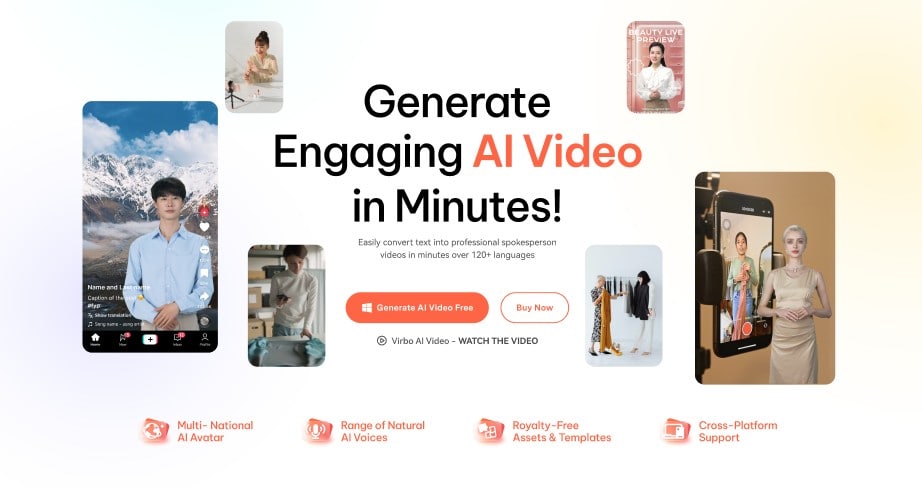
Part 1. AI Talking Photo Technology Benefits
AI-talking photos are revolutionizing how we communicate visually, merging images with audio narration to create immersive storytelling experiences. These photos offer personalized interactions that meet the preferences of users and enhance accessibility for all.
Thus, talking photos has become a cornerstone in modern communication across various industries, from advertising to education. With technology continually advancing, the potential for AI talking photos to deliver impactful messages is ever-expanding.
For a more comprehensive understanding, here’s a breakdown of the benefits of AI talking photo technology. Below are the following:
● Enriched Narratives
With AI-talking photos, storytelling reaches new heights that enable photographs to articulate themselves. Bymaking your pictures talk , the stories they tell become more engaging and immersive.
● Customization and Personalization
Users can now personalize their storytelling experience by narrating the stories behind their AI-generated photos using their voices.
● Accessibility and Inclusivity
AI talking photos also address the needs of individuals with visual impairments by providing audio descriptions of the images. This feature significantly enhances the accessibility of visual content, ensuring that everyone, regardless of their visual abilities, can engage with and enjoy the stories being told through the photos.
● Creating Lasting Memories
Throughmaking your image talk , they possess the ability to transform fleeting moments into enduring memories. The addition of audio narration enhances the emotional resonance of the images, making them more vivid and memorable.
● Facilitating Artistic Expression
AI talking photos provide a versatile platform for artistic expression, allowing users to experiment with various narratives, voices, and styles. The possibilities are endless, from personal storytelling to creative projects.
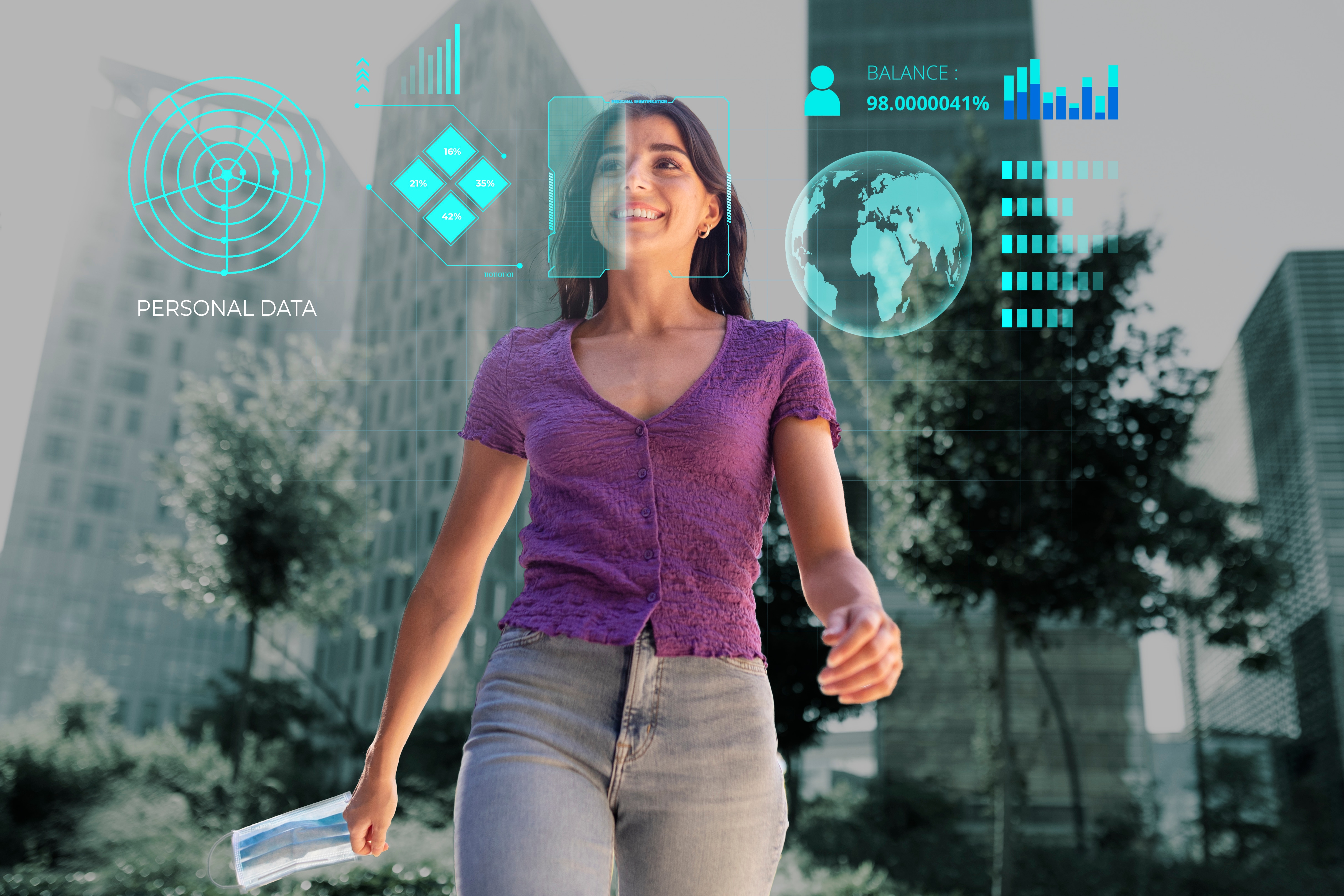
Part 2. Difficulties in Talking Photo Technology
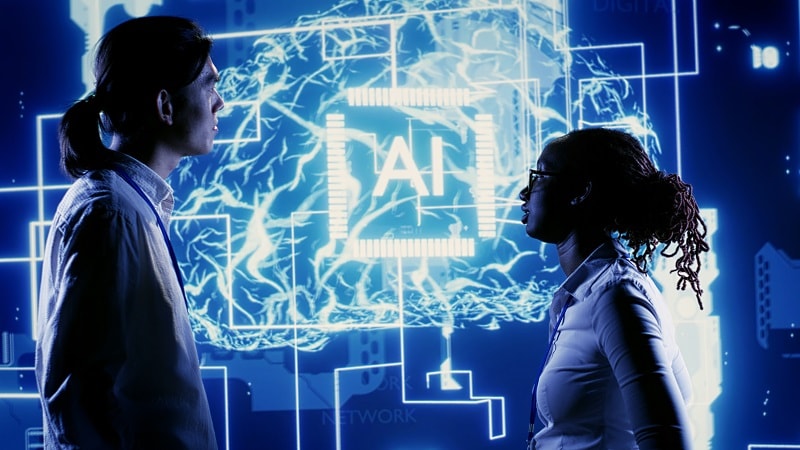
Despite its potential,making your photos talk encounters numerous challenges that hinder its seamless integration and effectiveness. Here, we outline some difficulties you might encounter:
● Unnatural Mouth Shape
Despite advancements in facial recognition and animation, creating natural-looking mouth movements in talking photos remains a significant challenge. The technology often struggles to accurately replicate the intricate movements and subtleties of human speech.
● Unnatural AI Voice
Another obstacle lies in the synthesis of natural-sounding AI voices. While text-to-speech (TTS) technology has advanced significantly, AI-generated voices can still sound robotic or unnatural. They often lack the nuances and inflections of human speech. Crafting a voice that is clear and emotionally resonant poses a significant challenge, as it involves capturing human expression and intonation nuances.
● Lack of Lip Non-Actuation in Multi-Person Conversation Photos
In multi-person conversation photos, accurately synchronizing lip movements poses a complex challenge. Coordinating lip movements and distinguishing speakers is challenging, especially in dynamic group settings with diverse expressions and speech patterns.
● Technical Limitations
Real-time lip-syncing and audio processing require a lot of computer power. Handling large amounts of data while keeping quality needs efficient algorithms. Additionally, it’s hard to balance performance and resources in talking photo technology.
● Ethical and Privacy Concerns
Besides technical hurdles, ethical and privacy issues arise with talking photo technology. Manipulating visual and auditory content raises concerns about misinformation, privacy breaches, and potential misuse of digital media.
Part 3. How to Create a Talking Picture with A Powerful Tool - Wondershare Virbo on Mobile/Online
In the current dynamic digital landscape, the merging of visuals and audio has reshaped our methods of communication and connection. Talking photos, with their capability to infuse images with voices and feelings, lead this transformative shift.
Wondershare Virbo stands as a testament to innovation in visual storytelling that offers a powerful platform that redefines how we engage with images and sound. With its cutting-edge technology, it effortlessly merges audio with visuals and surpasses the constraints of traditional static imagery. This breakthrough allows creators to transform ordinary photos into captivating narratives that resonate with depth and emotion.
Enter the realm of visionary storytellers and explore Virbo—a tool worth discovering to enhance your storytelling to new heights! Users can utilize it for mobile or online which ensures accessibility and convenience for their needs. Moreover, exploring Virbo online offers the same excitement and fluidity as using it on a desktop that guarantees an engaging experience on either platform. To create a talking photo on mobile/online, follow the steps outlined below:
Get Started Online Free Download
For Mobile
To create a talking photo on mobile, follow the steps outlined below:
- Download and open the Wondershare Virbo app and select the talking photo feature to access the operational interface.
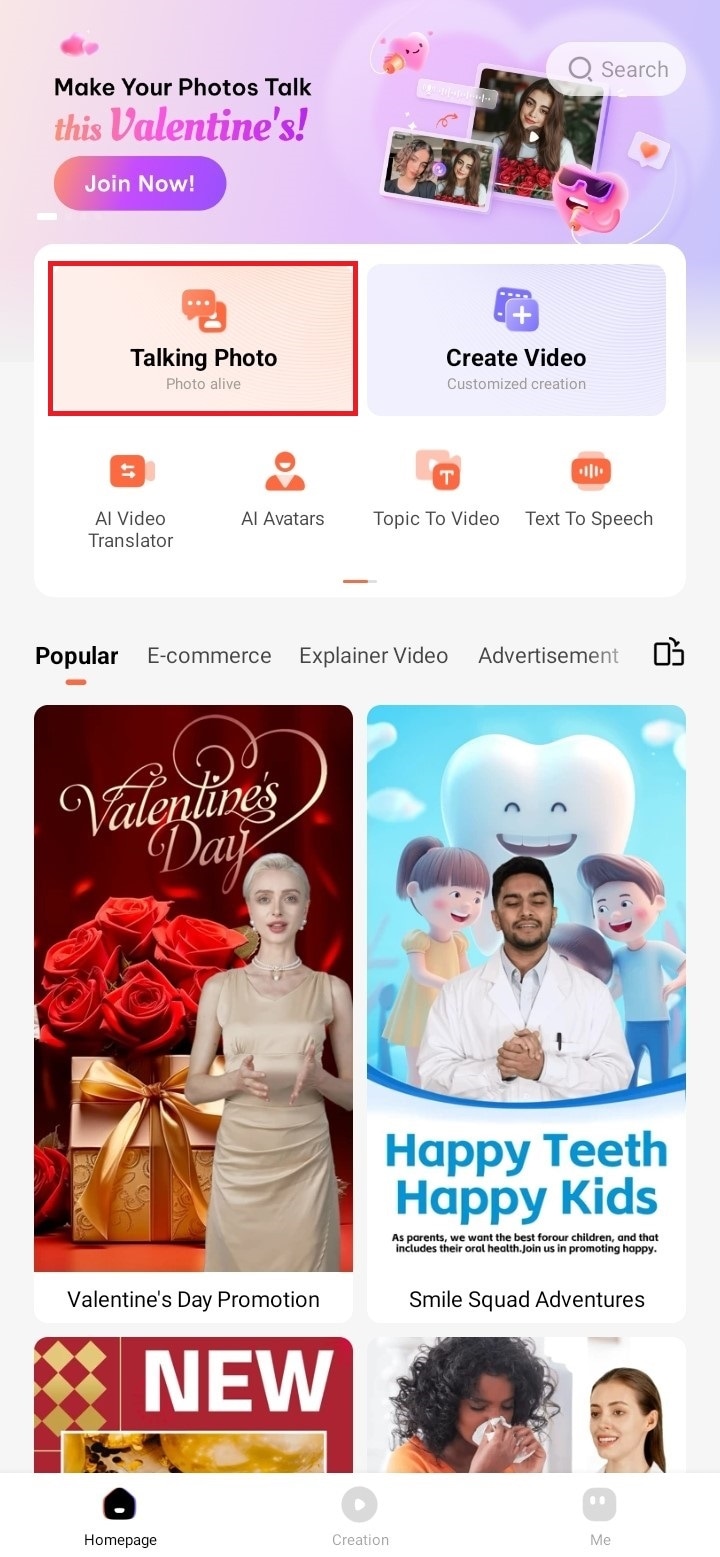
- Choose the AI-generated talking photo that best suits your preference, or you can select to upload your image.
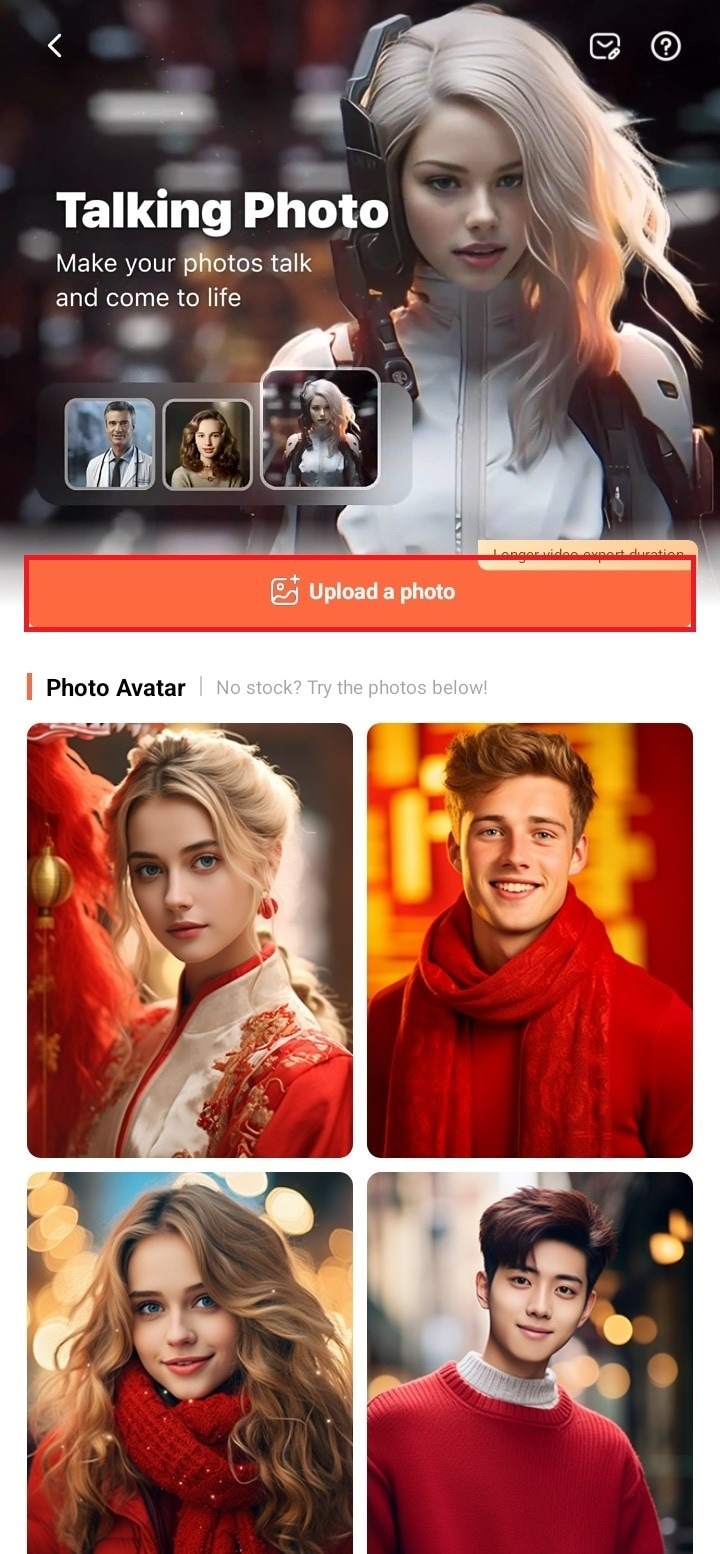
- Once you’ve chosen the AI talking photo you prefer, simply click on theCreate Video button located below.
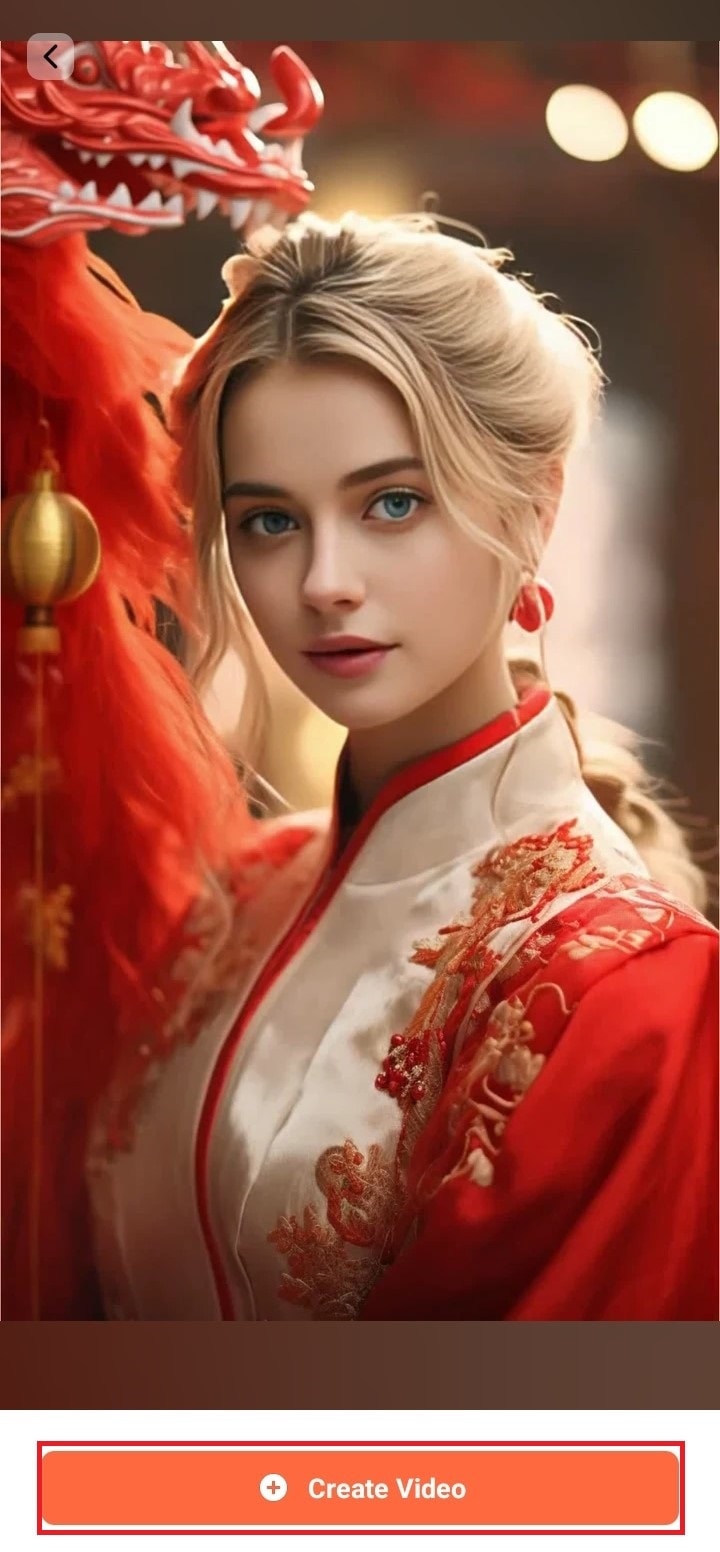
- Input your text and select a voiceover from the options below to create the audio for your video. Alternatively, you can record your voice by selectingrecord audio . When finished editing, tapGenerate Video to export it.
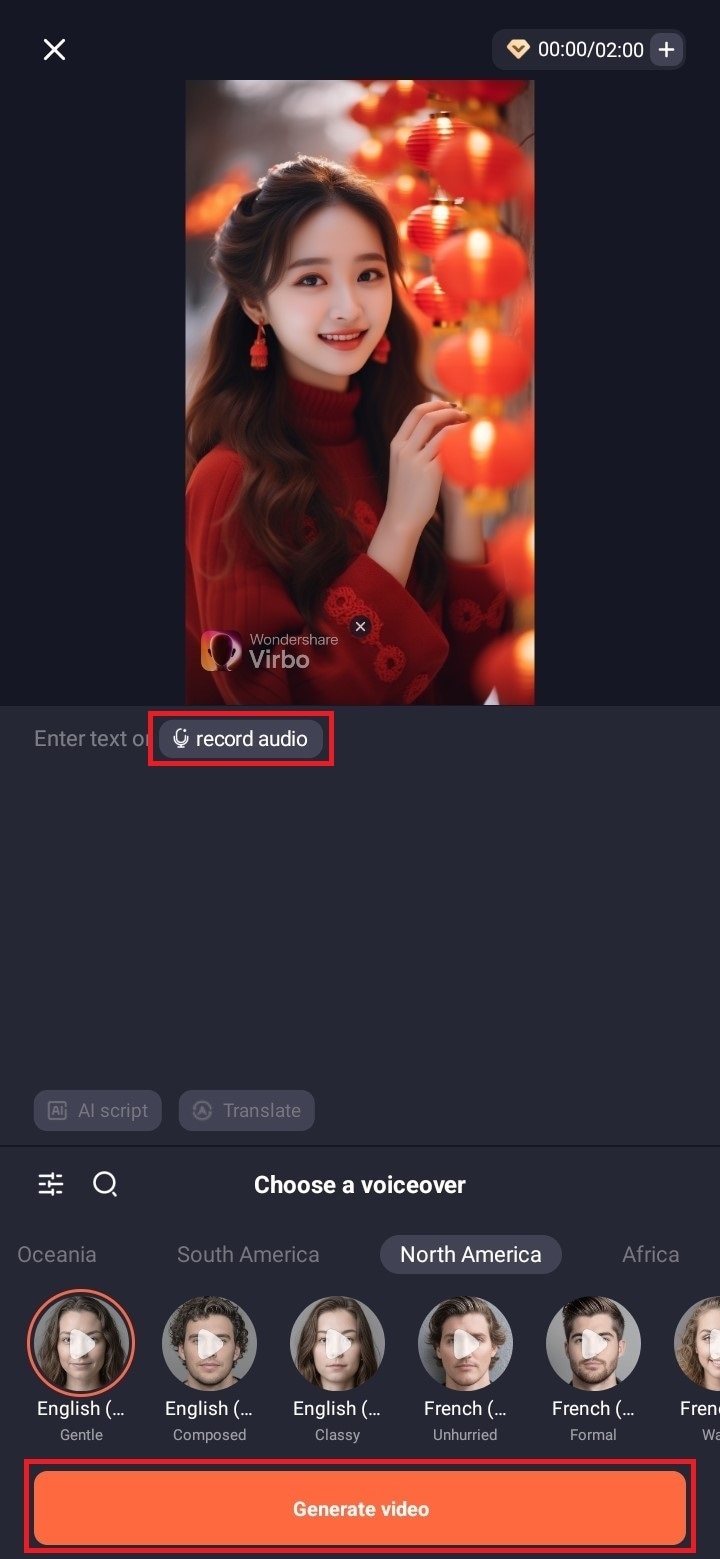
For PC
Tomake pictures talk online or on your PC, here are the following steps:
- Launch the Virbo on its website and click the Talking Photo option.
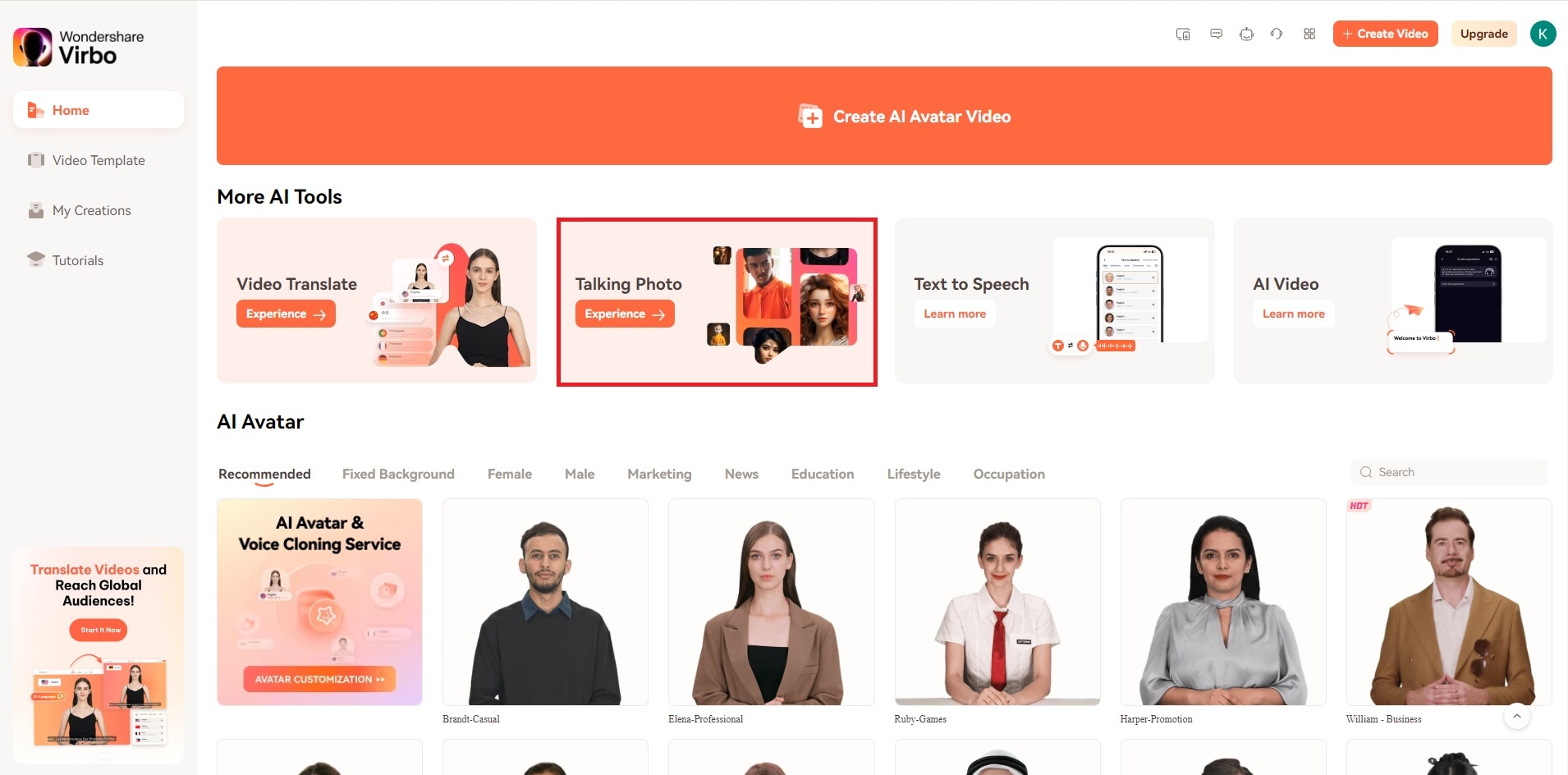
- You’ll encounter two options: either select from the images provided by this talking photo app or upload an image from your computer.
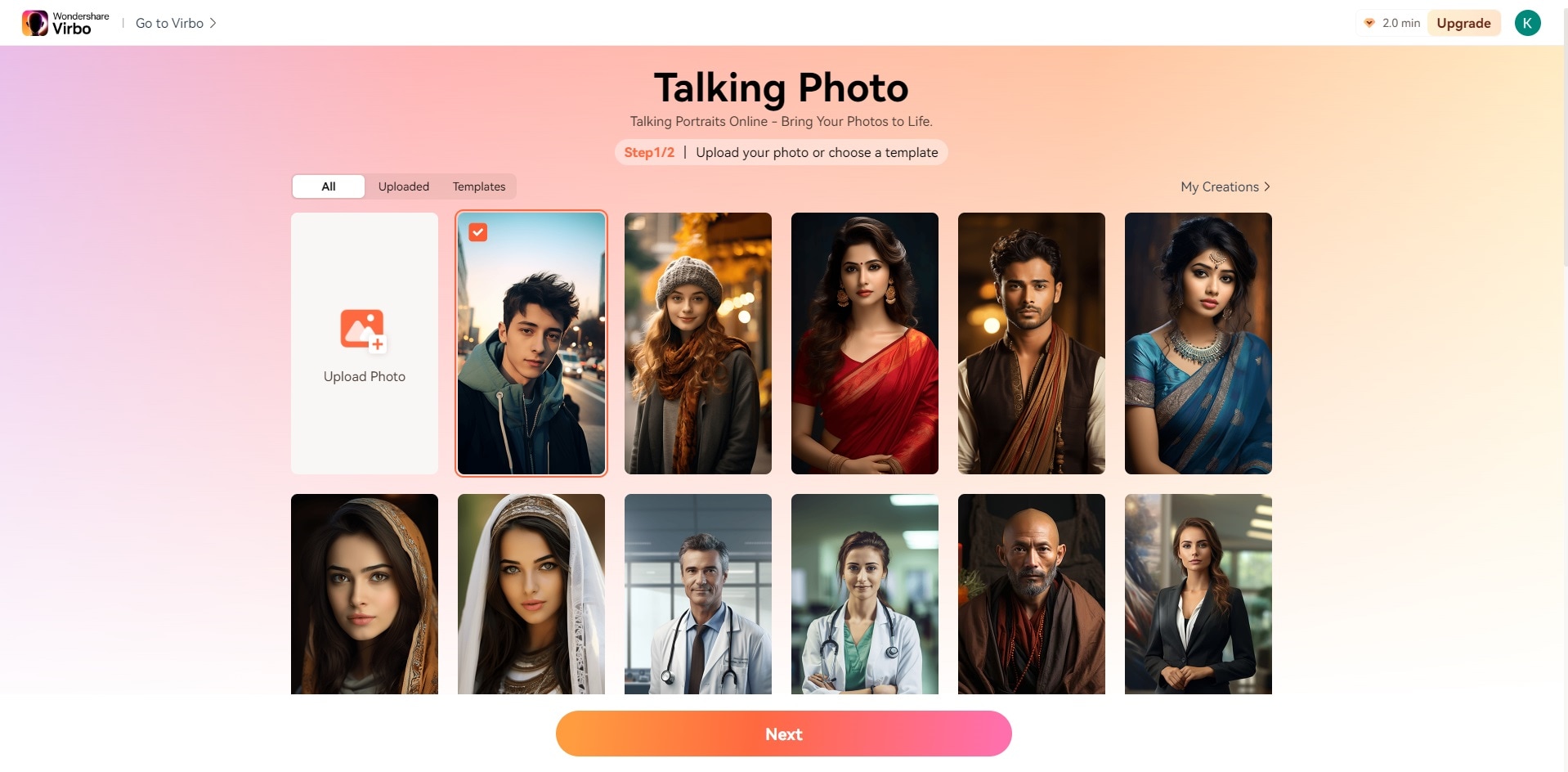
- To upload an image, click on theupload photo icon and review the User Agreement and Privacy Policy of Wondershare Virbo. Check the box to agree with the terms.
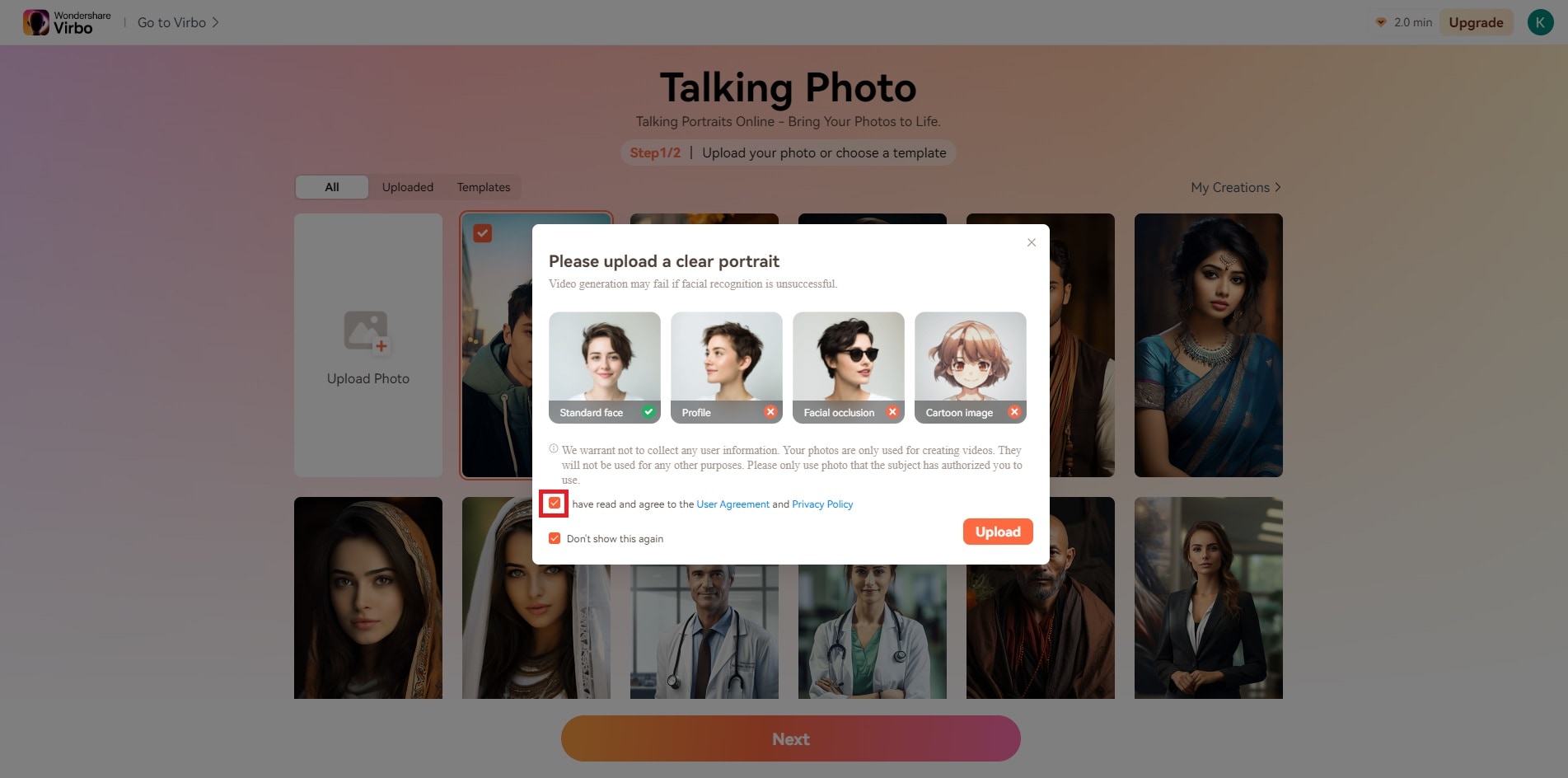
- Click the Upload button to select your image from the computer and open it. Tip: Choose a photo with just one person’s face in it.
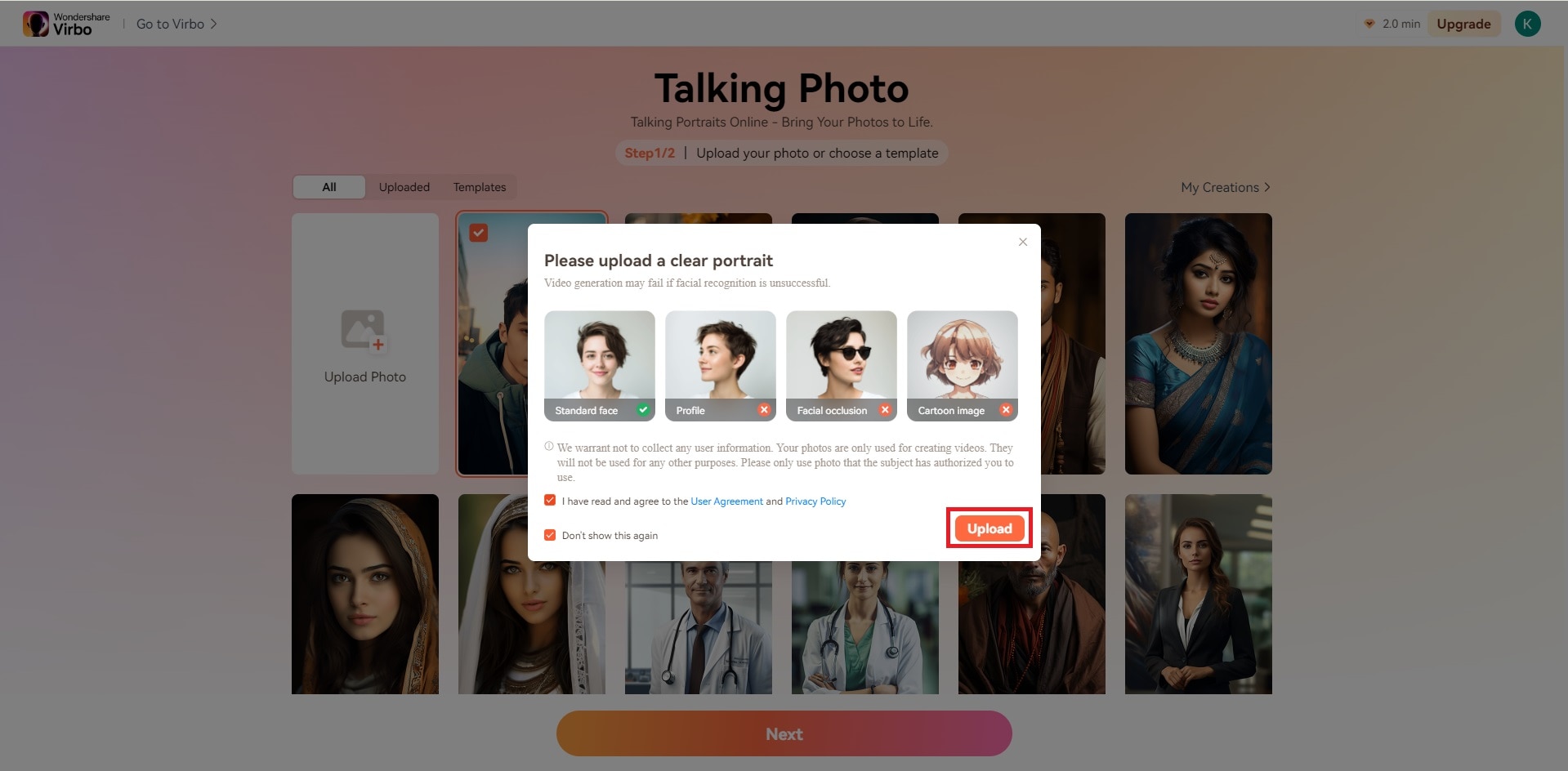
- Once uploaded, move your cursor to the Next button. Allow the app to set up your studio.
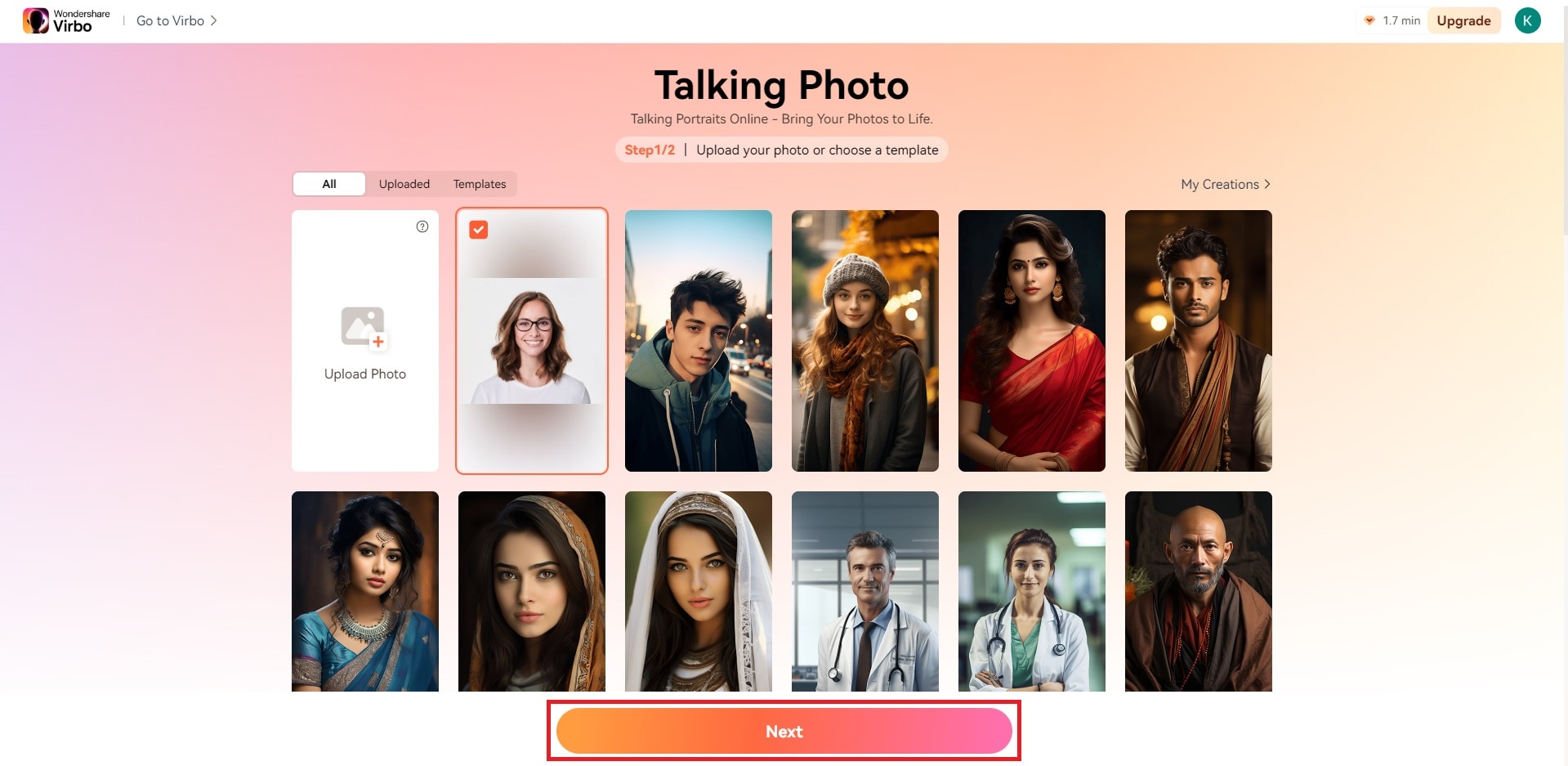
- When ready, enter the text you wish your photo to speak within the Text Script section. After inputting your script, adjust your voiceover settings from the section located at the bottom right of the page.
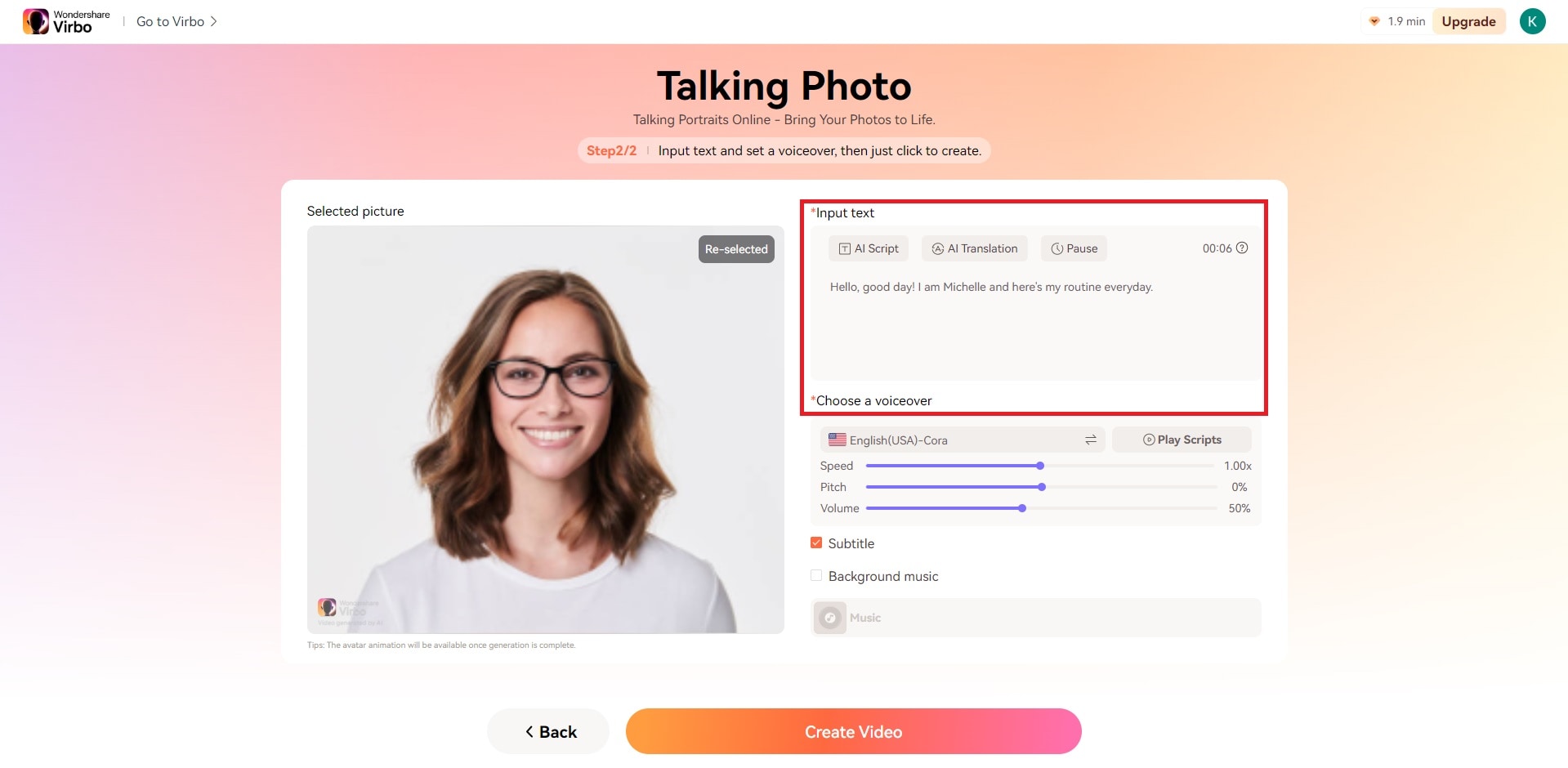
- Here, you can modify the speed, pitch, and volume of the audio. Select the language and gender of your voice and then click OK.
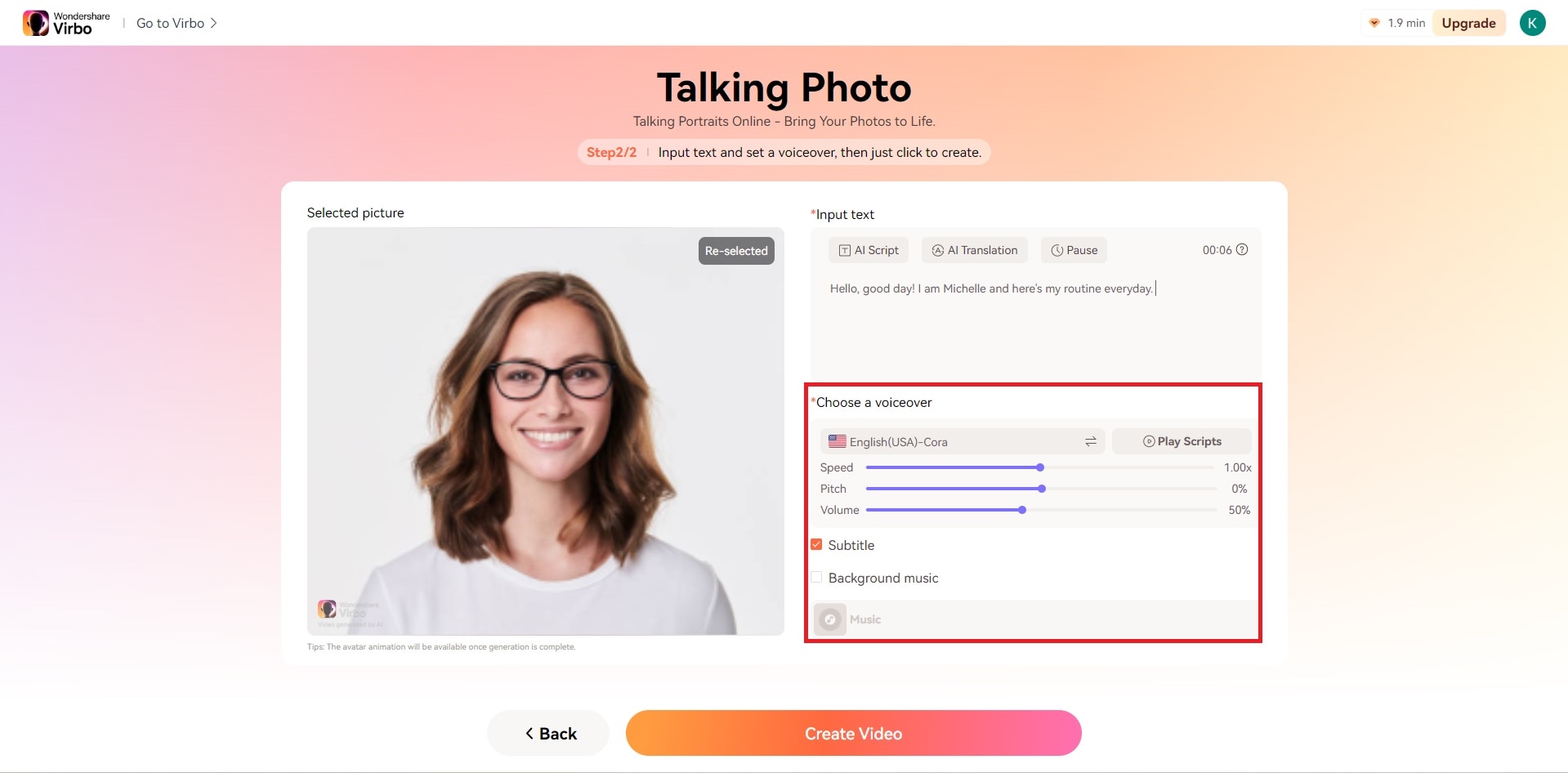
- Experiment with various voices and scripts to discover the perfect match for your photo. When finished editing, click the Create Video button.
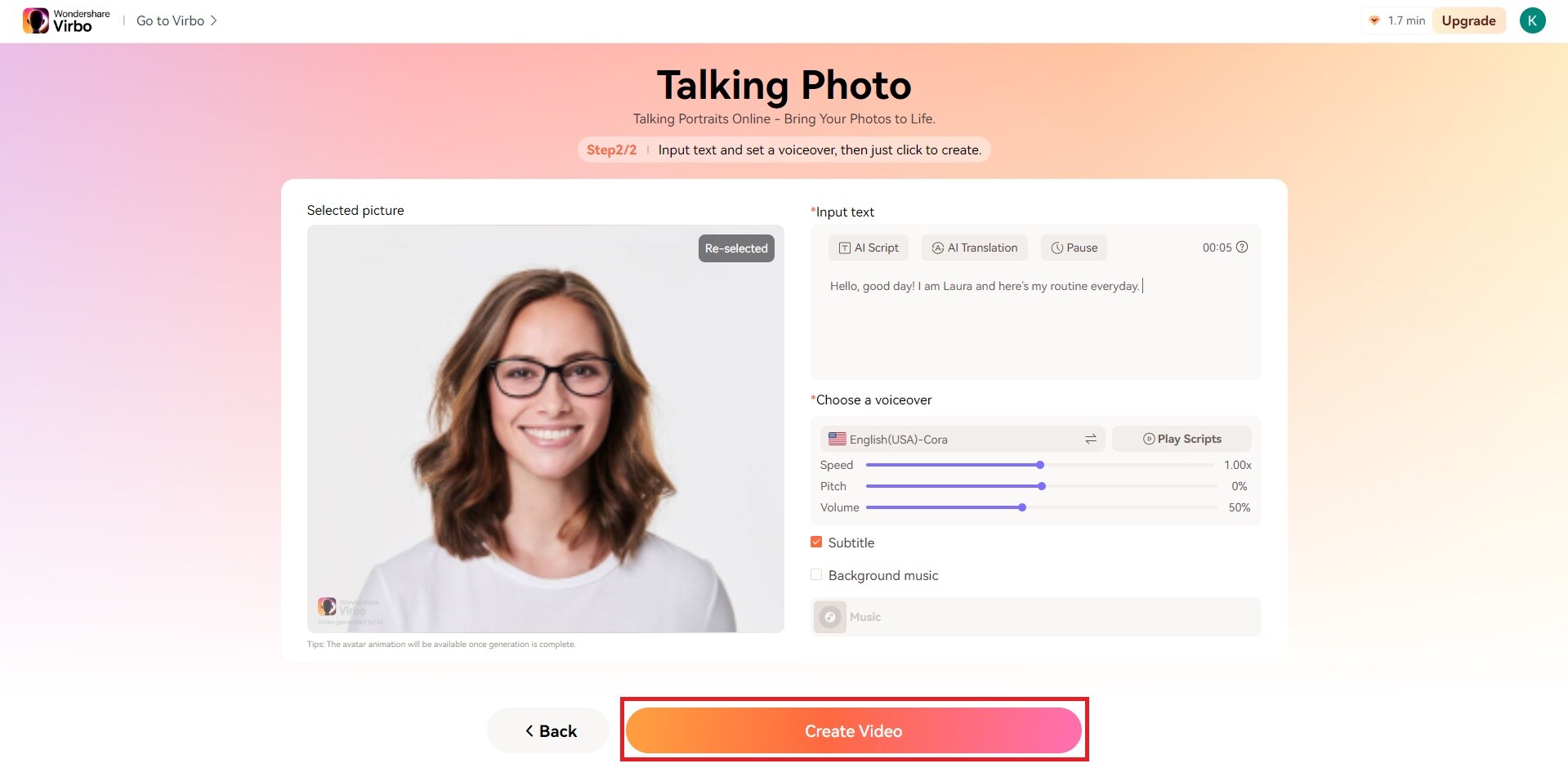
Conclusion
Recognizing the importance of embracing new technology is vital in today’s fast-paced environment. We must acknowledge and integrate these advancements into our lives seamlessly.
One standout feature worth highlighting is Virbo’s Talking Photo functionality. This feature not only adds an extra layer of depth to capturing memories but also enhances communication by incorporating audio into images. By incorporating Virbo’s Talking Photo feature into our daily routines, we can enhance our interactions and experiences, underscoring the significance of embracing cutting-edge technologies.
Also read:
- [New] Tutorial on YouTube Thumbnail Extraction for All OS Enthusiasts
- 2024 Approved All About Kapwing Video Translation
- 2024 Approved Revamp Your Resonance The 7 Premier Voice Recorder Change Android Apps
- 2024 Approved Top 5 Tools to Convert Text to Audio Online for Free
- Capturing Classroom Talks on a Mac
- Diverse Template | Online for 2024
- Download/Install/Register/Uninstall | Wondershare Virbo
- Effortless Video Downloading: A Guide to Using the Most Trustworthy SonyLIV Downloader
- In 2024, How Many Attempts To Unlock Apple iPhone SE (2020)
- In 2024, Speech-to-Speech Voice Cloning A Breakthrough in AI Voice Industry
- In 2024, Talking Photo Feature
- In 2024, The Best AI Video Makers From Photos to Create Captivating Videos with Pictures
- In 2024, Translate Audio/Video Content From Spanish to English and Vice Versa
- Maximize Your Engagement with Full-Screen Facebook Videos for 2024
- New 9 Best French Video Translators Online and Download Options
- NVIDIA's Newest Windows Game-Ready Drivers: Download Now
- Unlocking Facebook Stories A Curated List of Download Methods
- Unveiling the Caixun: A Cost-Effective Dive Into Its 75 4K Android TV Capabilities
- Windows 10 Install Stuck at Just a Moment Loop [Fixed]
- Title: Updated Common Platforms
- Author: Sam
- Created at : 2024-10-02 20:11:13
- Updated at : 2024-10-08 18:17:21
- Link: https://ai-voice-clone.techidaily.com/updated-common-platforms/
- License: This work is licensed under CC BY-NC-SA 4.0.

